Full Sun Annuals: 28 Flowers For Full Sun
Most gardeners enjoy beautiful flowers in their yards. If you’re the same way, you should consider plants that can thrive in a sunny location throughout the summer. Plenty of full sun annuals come in bright colors, soft pastels, deep tones, and white, so there’s something for everyone.
Many of these are tender perennials grown as annuals – it all depends on your growing zone. These can be grown in containers, pots, window boxes, hanging baskets, planters, and/or garden beds. Delightfully, many of them are well suited for butterfly and pollinator gardens.
What is the Full Sun?
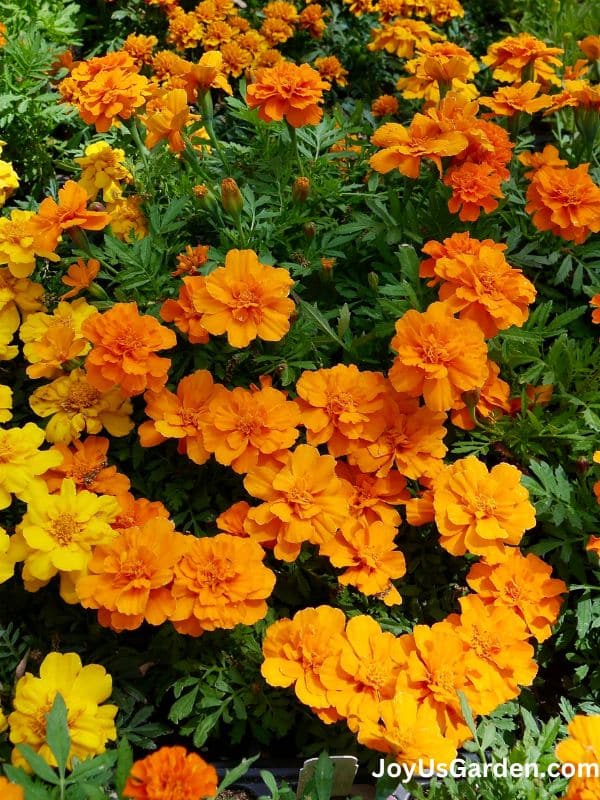

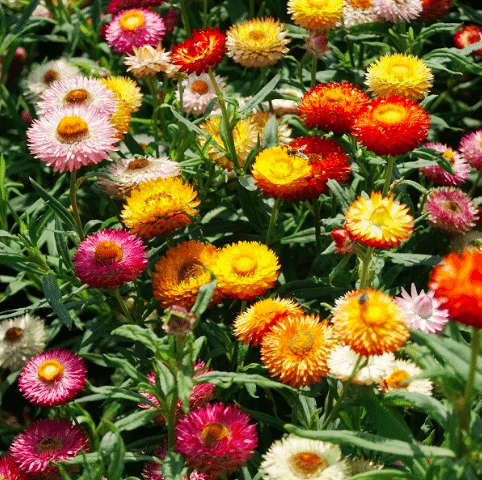
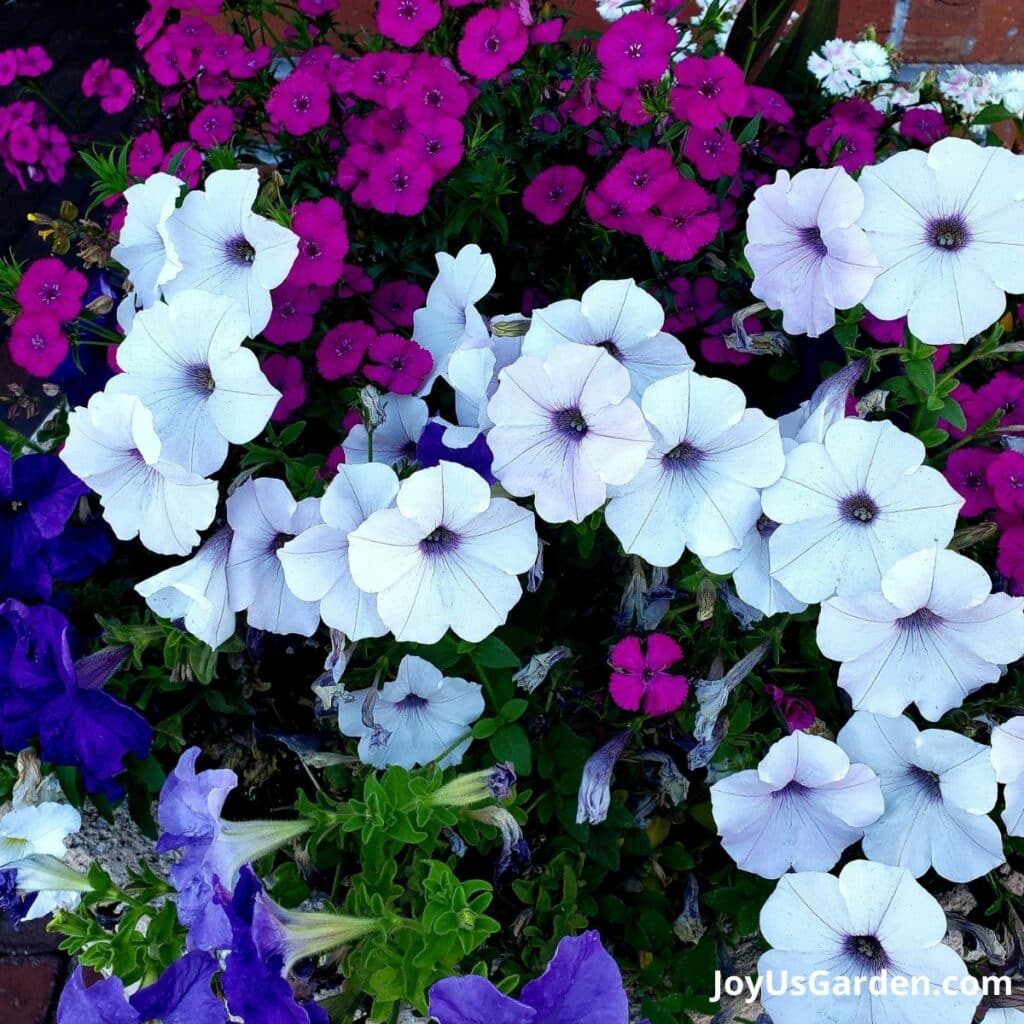
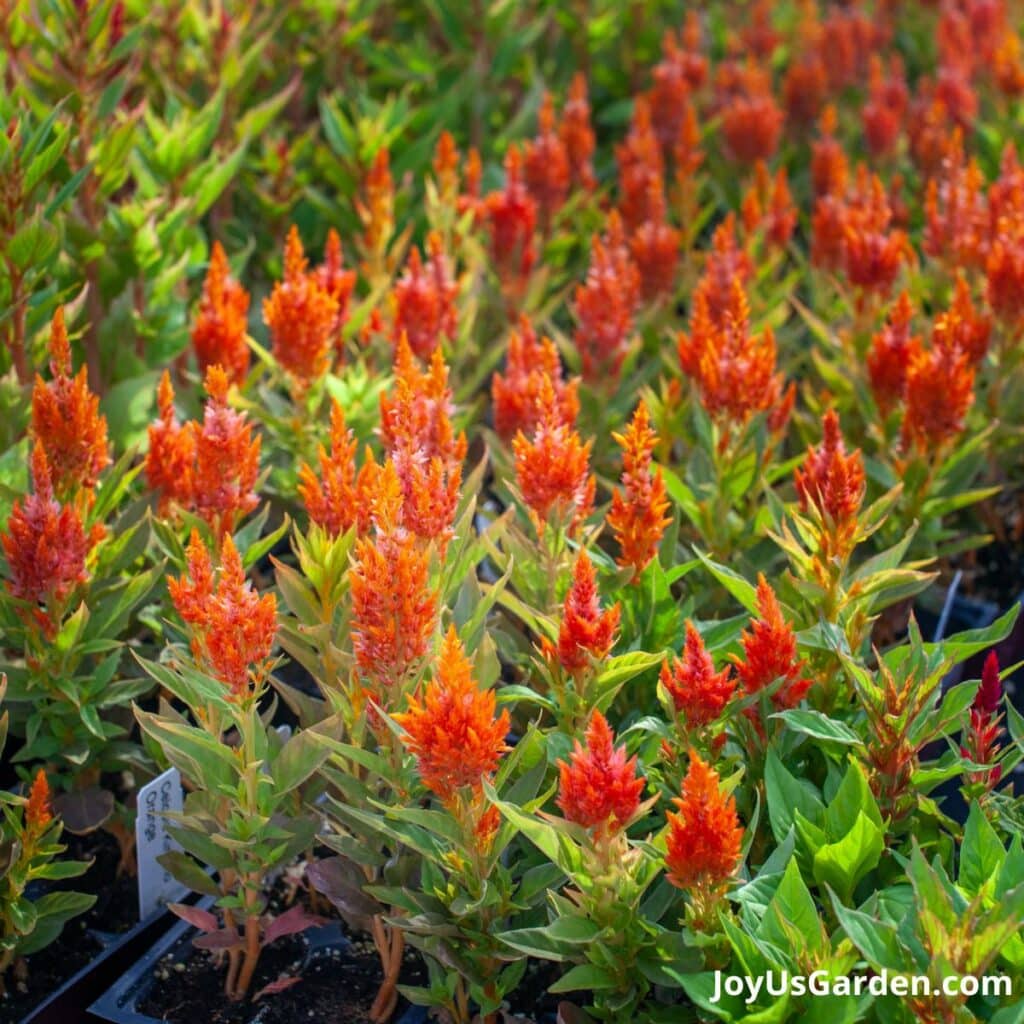
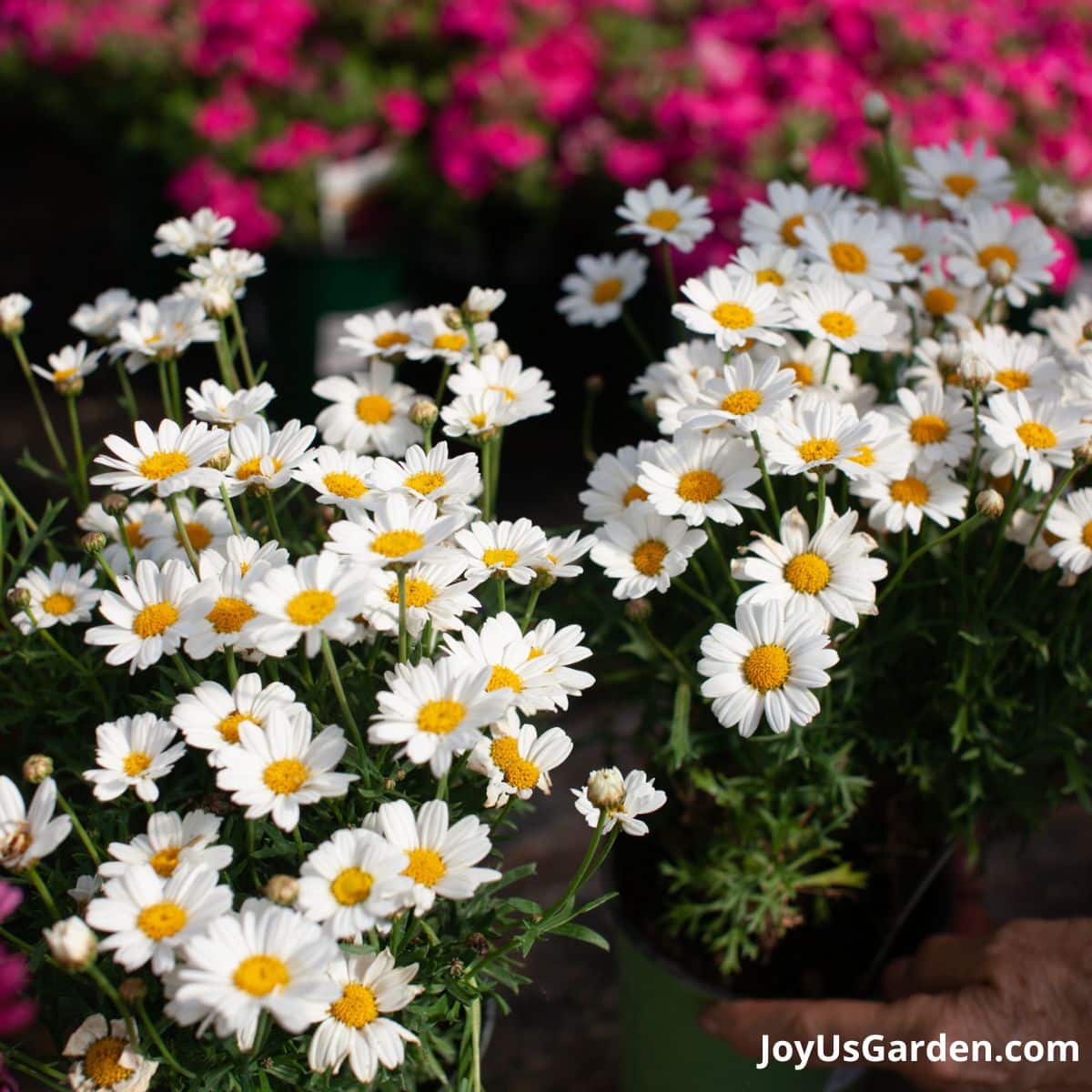
When we mention full sun, we’re talking about plants that can tolerate full sun exposure for most of the day or the entire day.
All plants require sunlight, but some perform much better in the shade or indirect light. Some of the plants listed below will tolerate partial shade (mainly in the morning), and most are low maintenance.
The intensity of the full sun varies depending on where you live. I grew up in New England, lived in San Francisco and Santa Barbara, and now live in Tucson, AZ. The summer sun is relentless here, so only a few summer annuals do well at this time. Remember, plants in our garden can’t escape to air-conditioned homes when it’s 90 degrees, and the sun is beating down outside!
Growing plants in the full sun can be challenging, but it’s doable with the right plants. The list below includes flowers native mainly to the southern United States, Mexico, and South America.
Get lots of info on flower gardening here: How To Prepare & Plant A Flower Bed and Organic Flower Gardening Tips.
Our Favorite Full Sun Annuals
Research and see what full sun annuals do well in your climate. Luckily, there are plenty of gorgeous flowers to choose from. Some will start blooming in late spring or early summer and continue into early fall.
They all like well-drained soil with organic matter (compost, worm castings, chicken manure, etc.) mixed in to add nutrition and aid drainage. When you plant depends on your growing zone, but a general rule is after the last frost date has passed and the soil has warmed.
This annual flower list with pictures (from A to Z) is suited for full sunlight. Most you can find at your local garden center and big box stores. We partner with Renee’s Garden (a high-quality heirloom seed company) and have included seed resources if you prefer to grow them that way.
Angelonia
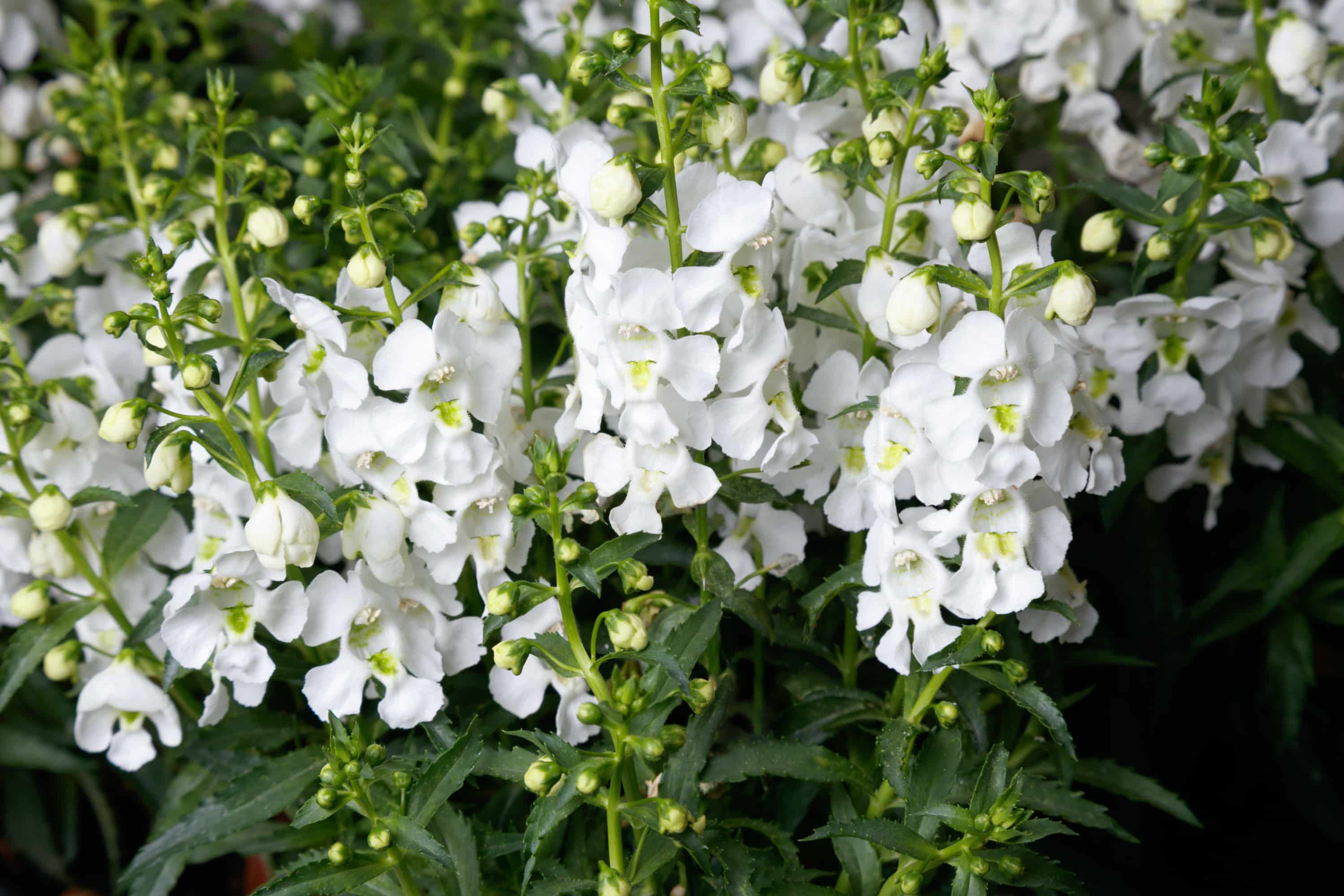
Their common name is Summer Snapdragon, and you can see the resemblance. Although the flower is much smaller, its structure is similar.
Depending on the variety, this tender perennial grows from 6″ up to 20 inches tall. The Angelonia maintains a bushy, rounded form, and some varieties cascade.
The flowers come in shades of white, pink, blue, and purple with a light fruity scent.
Calibrachoa
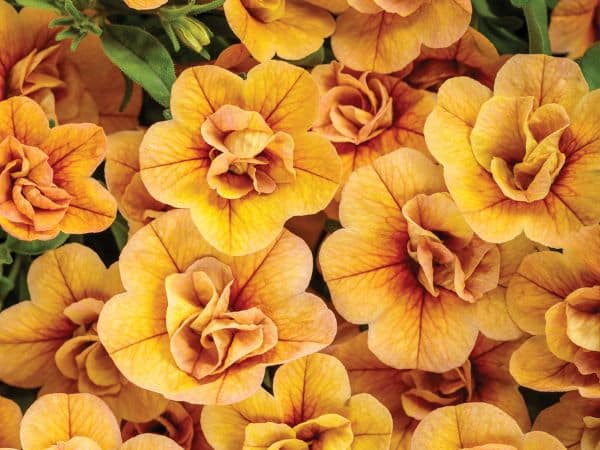
The Calibrachoa is a favorite for garden walls, hanging baskets, and window boxes.
This plant is relatively new compared to other plants, as it’s only existed since the 1990s.
They bloom non-stop all season long into fall. Although they look like mini-petunias, they don’t require deadheading, nor do they have sticky leaves.
And talk about a wide range of colors to choose from. White, yellow, apricot, orange, pink, rose, red, grape, and blue – something for everyone. The “Superbells” variety has double flowers.
They’re often called Miniature Petunias or Million Bells. This one is a winner!
Celosia
There are different varieties of Celosia – plumed, wheat, and crested. They provide a continuous bloom from early summer right on through to the first frost.
If you like bright and fiery full sun annuals with big flower heads, consider this one. They’re most recognized in yellow, orange, deep rose, and red. Cockscomb (the crested variety) is an old standby in fall bouquets. If you like more subdued colors and/or smaller flower heads, you can find them in white, pink, pale green, and bi-colors.
They range in height from 12″ to 36″ and stand out in the late summer garden.
Cleome
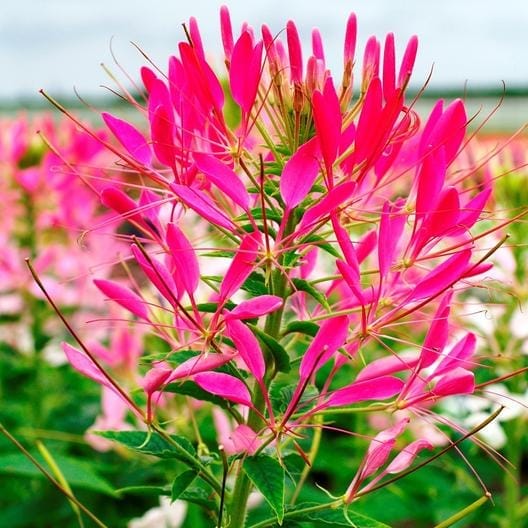
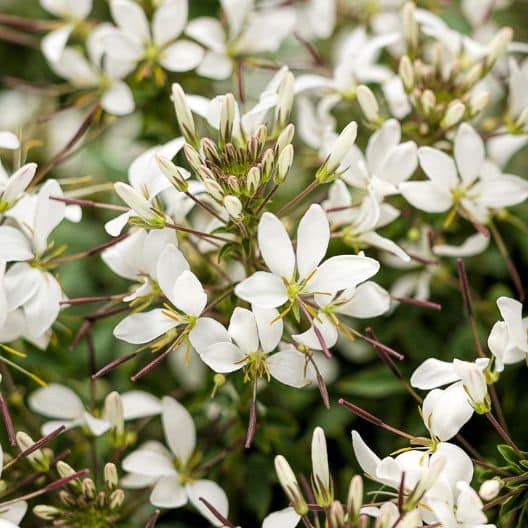
Also known as Spider Flower, the Cleome is so unique. Many gardeners miss out on this flower because it looks like a clump of weeds if you purchase it at the store.
I first saw these at the gardens at Versaille in late summer/early fall, and they knocked my sandals right off with those long, tall stems and big puffy flowers. Oh boy!
Cleomes are long and thin, and their height ranges from 3-4’. These tall flowers are good for the back of the border. They’re easily grown from seeds planted directly in the garden but can be started indoors too.
Many annuals here can be purchased in 6-packs, but I’ve only seen Cleome for sale in 4″ and 1-gallon pots. White, pink, and purple are the colors you can expect to see in your garden if you choose this plant.
Cosmos
The cosmos are a good choice if you want a delicate-looking flower in your garden. White, pink, orange, yellow, and scarlet are the colors you can expect to see.
There are many varieties of this cottage garden staple on the market now. If you’re looking for softer colors, try the Sensation Cosmos. If jazzier colors are your thing, then the Sulphur Cosmos is for you.
These daisy-like flowers with thin stems grow quickly and are easy to maintain. I love the way the taller varieties dance in the breeze.
Dahlias
Dahlias are stunning tuberous plants, and the smaller varieties are sold in 4″ and 6 packs. If you live in a colder climate and don’t want to dig the tubers up and overwinter them, buying them in pots or treating them as annuals is the way to go.
You have a lot of choices with this plant. Dahlia flowers come in many forms and a wide array of colors. They range from single to pom pom to cactus to dinner plate in shades of white, yellow, orange, pink, peach, rose, red, purple, and maroon-black. The flowers on Dahlias range from 2″ to 15″ in diameter.
They grow equally well in containers as well as in the garden. If you want gorgeous cut flowers, consider Dahlias, which bloom from mid-summer into fall.
Daisies

There are so many daisy-like flowers on the market. You can find perennial daisies and tender perennial daisies sold as annuals. I wanted to include these cheery flowers because they’ve been a favorite in gardens for a long time.
The ones I’m familiar with are white with yellow eyes, reach around 12″ tall, and are grown in 4″ pots and 6-packs. The marguerite daisies are taller, reaching 3′. Along with white, they come in shades of yellow and pink.
African Daises are also sold as annuals in many climates. They can reach 2’x 2′ and are available in a wide range of colors – white, yellow, pink, orange, red, lavender, and purple.
Dianthus
This carnation relative is a long-time staple in old-fashioned gardens. Just like salvias, there are perennial plants to choose from also.
The annual dianthus is found in white, pink, rose, lavender, and bi-colors. A bonus is that the single or double flowers are lightly fragrant.
They reach 12″ -24″ tall and have grey-green or blue-green foliage. These fringy beauties are a butterfly favorite.
Geraniums
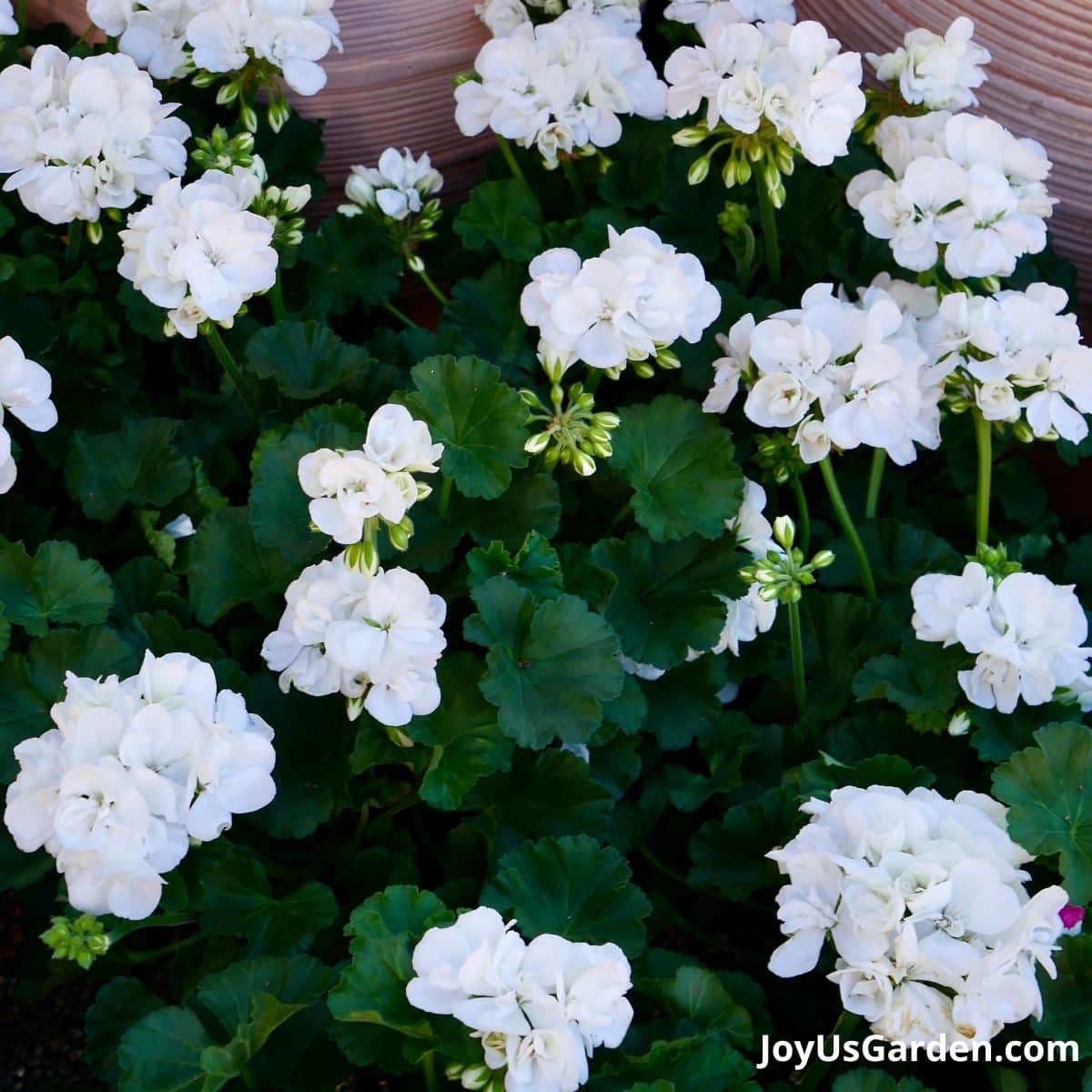
These favorite flowers were popular way back when and are still going strong. They’re a great addition to any container garden. You can’t beat these large flowered beauties for a major pop of non-stop color!
Zonal Geraniums (which are technically Pelargoniums) grow fast and flower profusely. They’re bushy plants with a mounding form reaching 16″ x 24″.
The color selection includes white, pink, red, orange, salmon, violet, and bi-colors. This plant is known for its toughness and adaptability to dry conditions. We saw them growing in olive oil tins when traveling the Greek Islands, and all were flowering away like crazy.
If you’re looking for plants like this one for hanging baskets, check out Ivy Geraniums. They trail, whereas the zonals have an upright growth habit.
Lisianthus
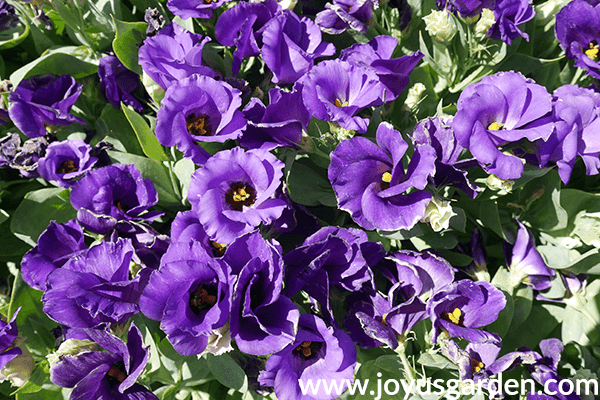
A popular plant due to its rose-like flowers, the Lisianthus is often used as an ornamental. They look better planted in groups and hold each other upright as their stems are very thin.
You need to know a few things to get them to thrive, but once you get it down, the gorgeous flowers are worth it. They’re so pretty and long-lasting in arrangements.
Heights range from 8″ to 40″. Find them in blue, white, pink, purple, and bi-colors. The beautiful buds rise above the flowers, making them a favorite in wedding bouquets.
Lobelia

This is an excellent choice to use as a low-border plant. I had a very large garden client, and we planted over 200 of these plants for her every year. She loved the color blue, and the Cobalt variety sure delivered.
Besides shades of blue, you can find it in white and rose. Like Alyssum, it’s readily sold in 6-packs, making it an economical choice. The plants grow 8″ x 12″ and can tolerate partial shade.
They have a long bloom time (into the fall), provide masses of color, and are great in containers where they can spill over the sides.
Marigolds
That pop of orange! Native to Mexico and South America, these bright, colorful flowers also come in yellow and red. You can find them in solid colors like “Lemon Drop” and bi-colors like “Court Jester”. There are now white varieties, but the more colorful ones are easier to find unless you grow them from seed.
These are very independent plants because once they are planted, they take off. Marigolds grow in no time.
Here are a few different types of Marigolds:
- African – Tall
- French – Much shorter
- Triploid – A mixture of both African and French; they grow in a variety of colors
- Single – Resemble daisies
These are among my favorite full sun annuals and are often used in the vegetable garden to keep pests away.
Here’s some of our gardening posts you’ll find helpful: How To Sharpen Garden Shears: Cleaning & Sharpening Pruning Tools, Vegetable Container Gardening, Feeding Roses FAQ’s, Organic Gardening At Home, Herbs For Full Sun, Repotting Plants & Organic Flower Gardening.
Morning Glory
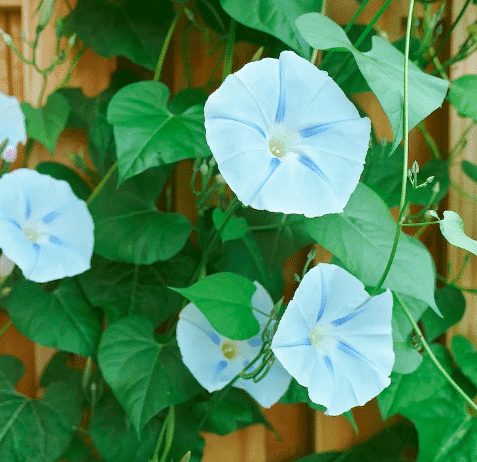
Morning Glories have been special in my heart since childhood in New England. We grew them up our lamposts in Litchfield County every summer, directly sowing the seed in the ground.
Morning Glories are vining plants with trumpet-shaped flowers. They’re vigorous, tall growers that can be trained on a trellis, pillar, lampost, fence, etc., just like Sweet Peas.
The flower is most recognized in shades of blue, but you can also find them in white, pink, red, maroon, purple, and bi-colors. Some varieties grow to over 12′ tall, so make sure you have a big enough means of support!
Nemesia
The Nemesia is a foreign flower that comes from South Africa. They prefer cooler temperatures. Although they can still live through temperatures into the 90s, they don’t tolerate hot sun.
Like others listed here, this one’s technically a tender perennial but sold and grown as an annual.
I used this one quite a bit when I was a professional gardener in the San Francisco Bay Area, as the coastal areas have cool summers.
These sweet mounding compact plants that grow to 10″ – 20″ come in white, yellow, orange, pink, red, blue, and violet. There are a few bi-colored varieties too.
Penta
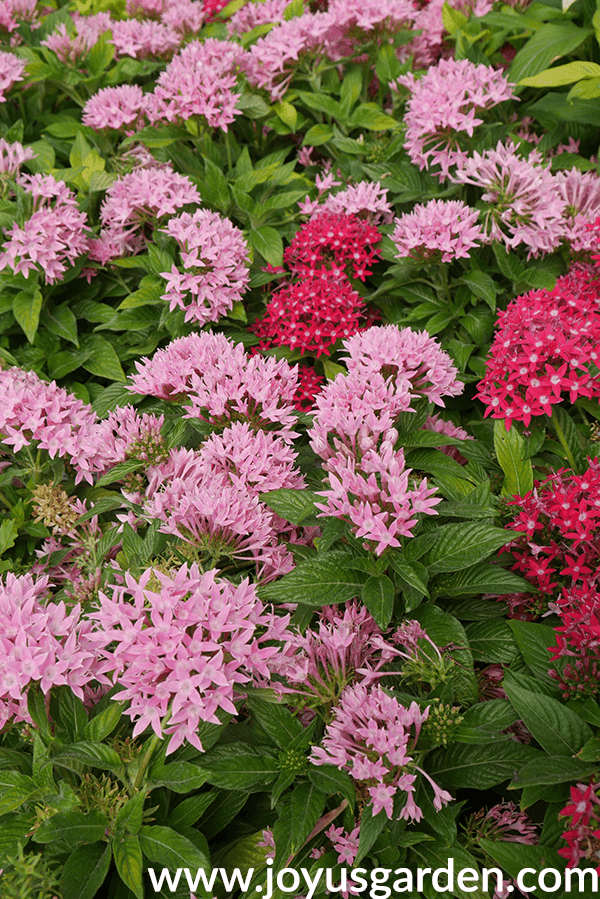
Because of this bloom’s five-point shape, the Pentas are known as Egyptian stars.
They grow in a mound shape, and their size goes from 12″ up to 30″ tall. You can find them in white, pink, lavender, and red.
If you want to attract butterflies, hummingbirds, and bees to your garden, this is one of the best plants that attract the pollinators you’ve been looking for.
Petunias
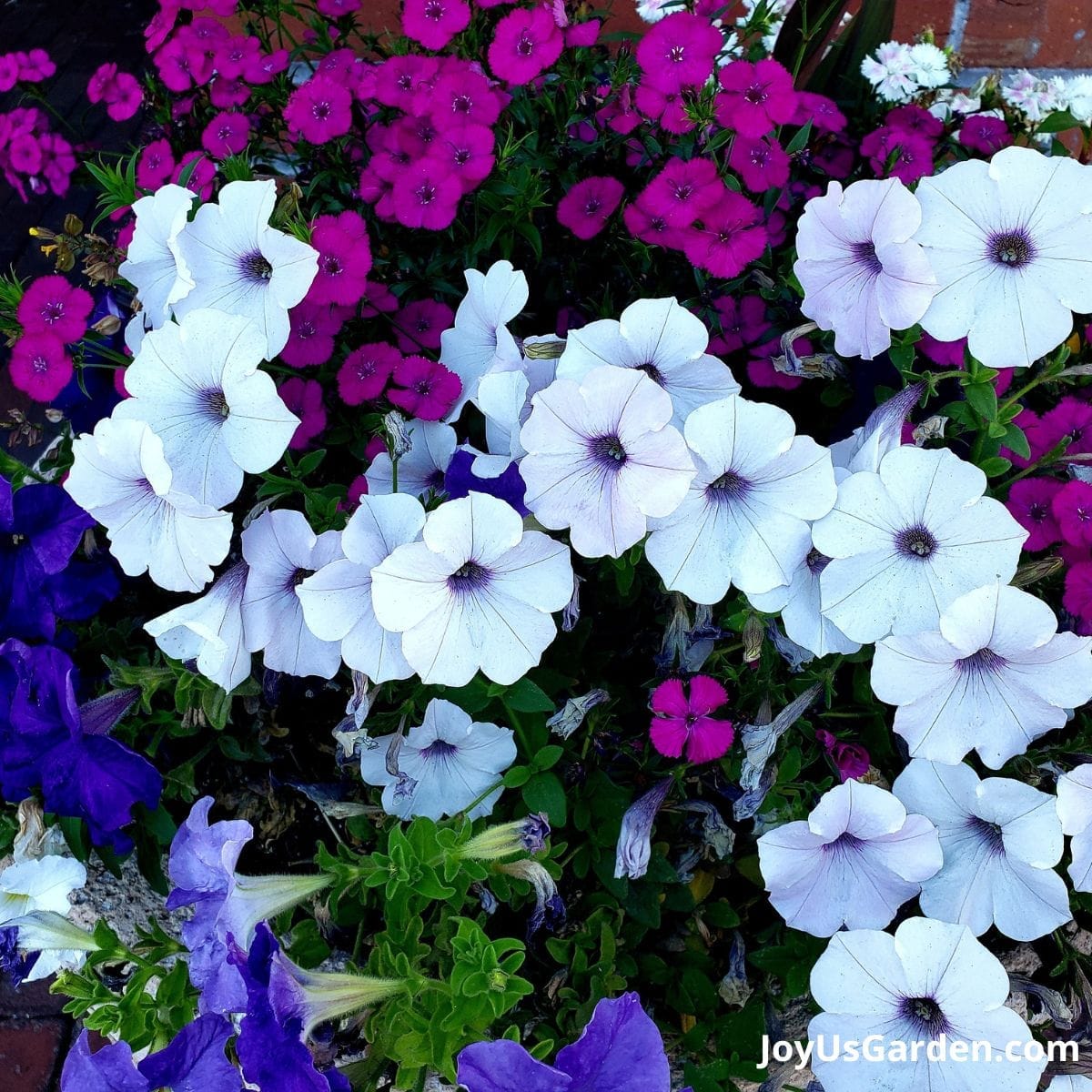
Petunias are one of the easiest annual plants to find and maintain. These full sun annuals have been on the scene for ages and, in the past, have been the quintessential summer full sun bedding plant.
You have so many choices with Petunias now because they’re sold in various colors, from white, yellow, pink, red, orange, purple, multi-colors, and even black, if you like deep and dramatic flowers. These bedding plants also come with single or double blooms.
If you want a petunia with a cascading/mounding form, check out the Supertunias / Wave Petunias listed further down. They’ve become very popular and are now in their own category!
Poppies
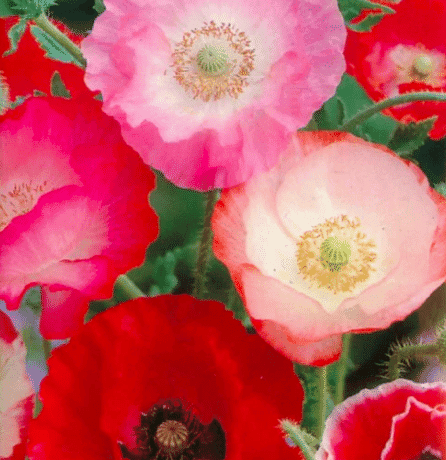
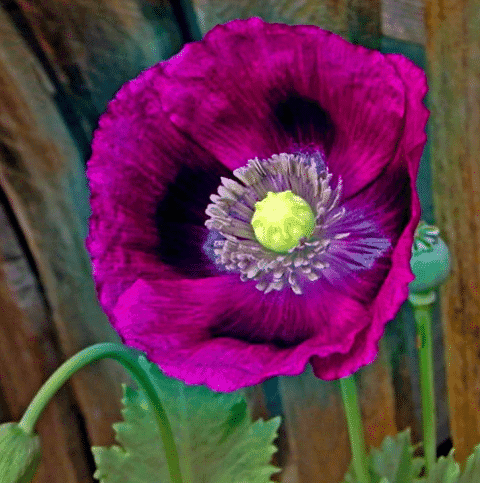
Poppies have papery blooms that flutter in the wind. Some of the annual poppies tend to perform better than their perennial cousins in poorer soil conditions.
The most popular are the Shirley Poppies, Flanders Poppies, Somniferum Poppies, and California Poppies. They range in height from 10″ to 40″, determined by the type.
Some come in softer pastels, and others, like the showy Somniferum Poppies, come in quite dramatic colors (check out Black Swan, and you’ll see what I mean). The color range is white, yellow, apricot, orange, pink, rose, red, purple, maroon, and nearly black. They bloom from late winter into summer, depending on the type.
Portulaca
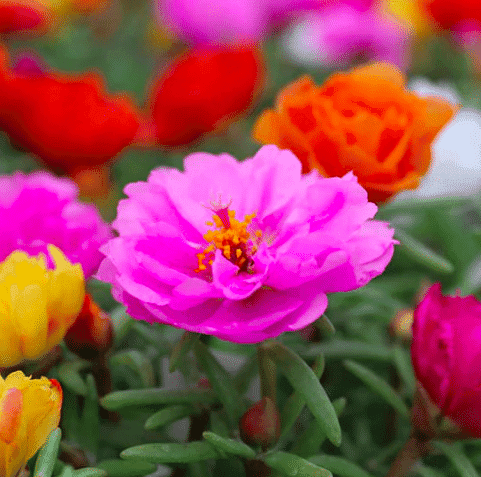
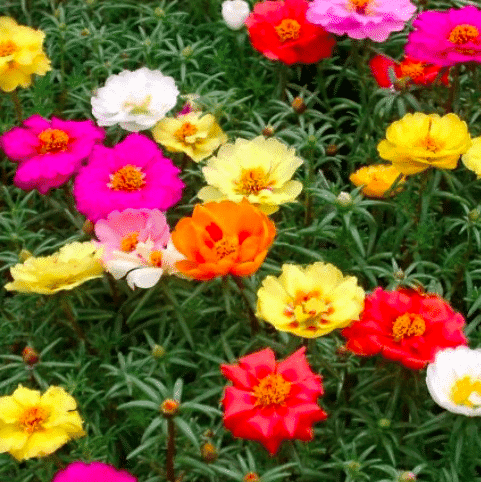
Also known as the sun rose or moss rose, the Portulacas are annual succulents. These have a low-growth habit and are often used in hanging baskets, in rock gardens, and as ground cover.
They’re heat and drought-tolerant, ideal for hot, sunny areas. In addition, Portulacas are fast growing and are very easy-care.
The bloom typically grows into a white, yellow, pink, orange, or red flower. This ground-hugging annual reaches 6″ tall x 12″- 20″ wide, depending on the variety.
Salpiglossis
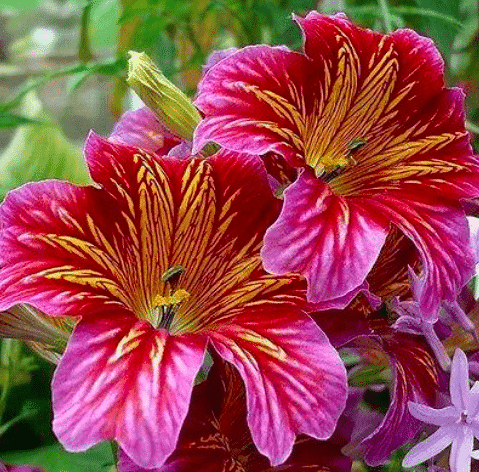
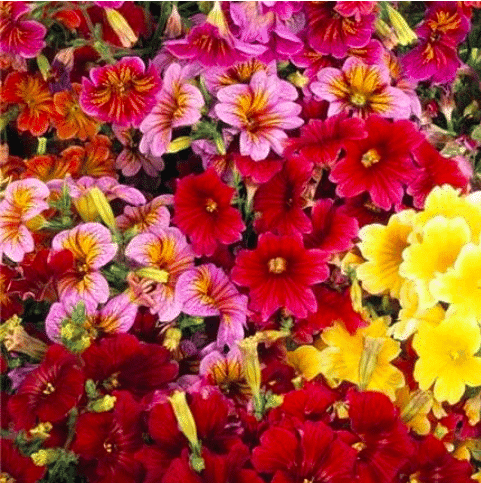
Typically grown as an ornamental plant, the Salpiglossis resembles the Petunia but grows taller. This one isn’t commonly sold everywhere, but it sure is a beauty.
This old-fashioned flower reaches 2’ tall and looks like the blooms have been hand-painted. The common name Painted Tongue is so fitting for this one.
The flower color runs the gamut from white to yellow, red to blue, and even brown. With some varieties, different colors appear in the same bloom.
Interested in more info on flower gardening? We’ve got you covered with this post on Organic Flower Gardening and Preparing & Planting A Flower Bed.
Salvia
The flower spikes rise above the foliage, which grows neatly. The red salvia pictured above on the left was very popular when I was growing up. The newer varieties have large flower heads and bloom from summer into fall.
Besides red, you can find this plant in white, pink, and blue. They max out at 24″- 30″. Pollinators adore this plant, so it’s a good addition to the garden if that’s what you want.
There are so many perennial salvias on the market too. Some of the annual salvias will overwinter in warmer climates.
Strawflowers

Strawflowers are lovely plants that will reward you with beautiful pops of colors from July through fall. Their petals feel like paper to the touch and hold their color long after being harvested and dried.
The color selection includes white, yellow, orange, apricot, and red. They range in height from 15″ to 36″.
You can enjoy them in the garden, and after summer, you can cut them back and use them in your dried flower arrangements, for wreath making, and for other decor projects. These always remind me of second summer!
Sunflowers
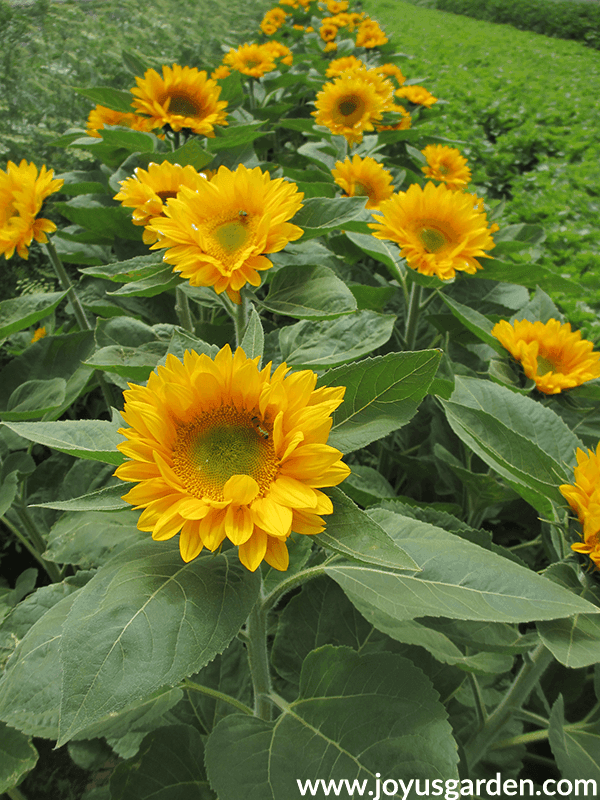
Sunflowers are like a ray of sunshine and can thrive in mid-summer heat. They’re fun for kids to plant and watch grow, especially the taller varieties. The birds are attracted to the seeds, serving a dual purpose.
Gone are the days of only the 6’ yellow sunflower. Many sunflowers are on the market now in various sizes, forms, and flower colors – ivory, yellow, orange, red, and bi-color. Along with the single-stemmed varieties, you can find multi-branching ones too.
Whether you choose one that grows to 12’ or 1’, you can’t miss these showy flowers in the garden!
Supertunias / Wave Petunias
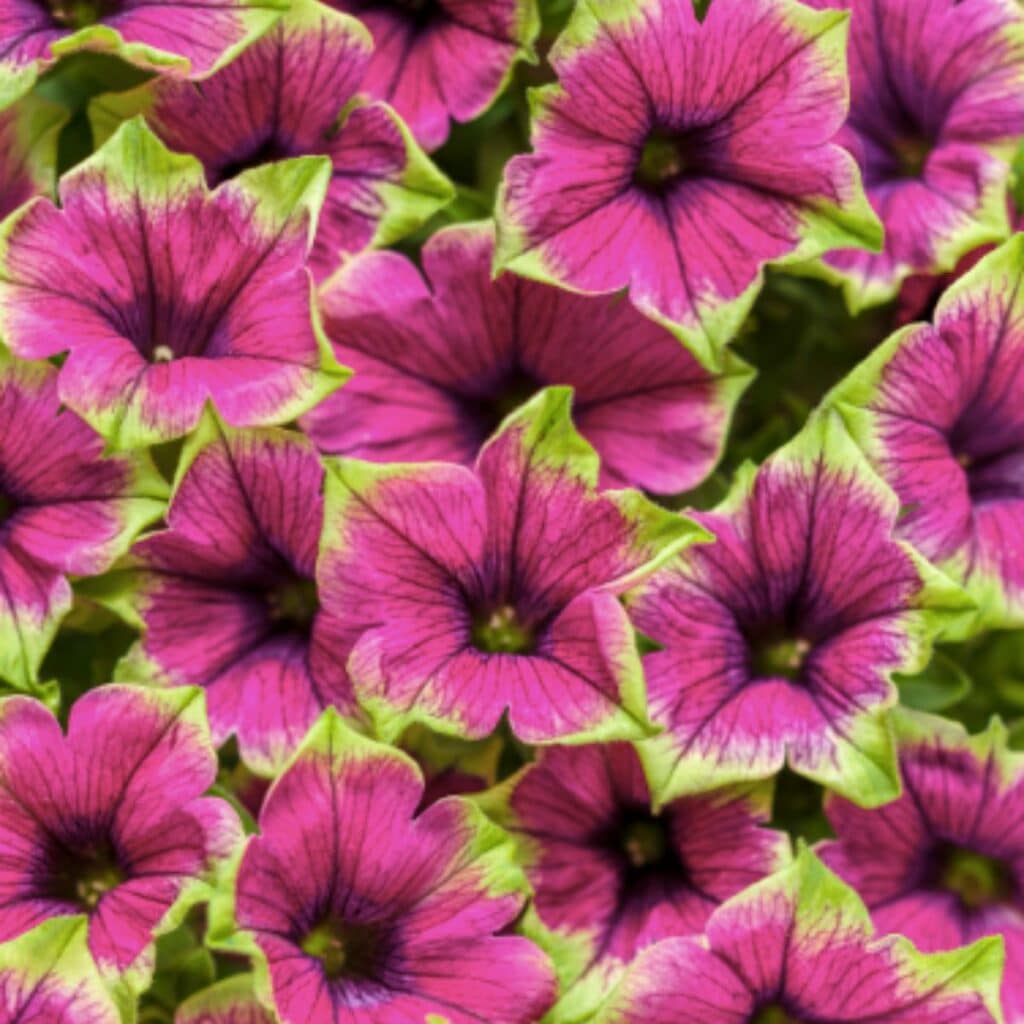
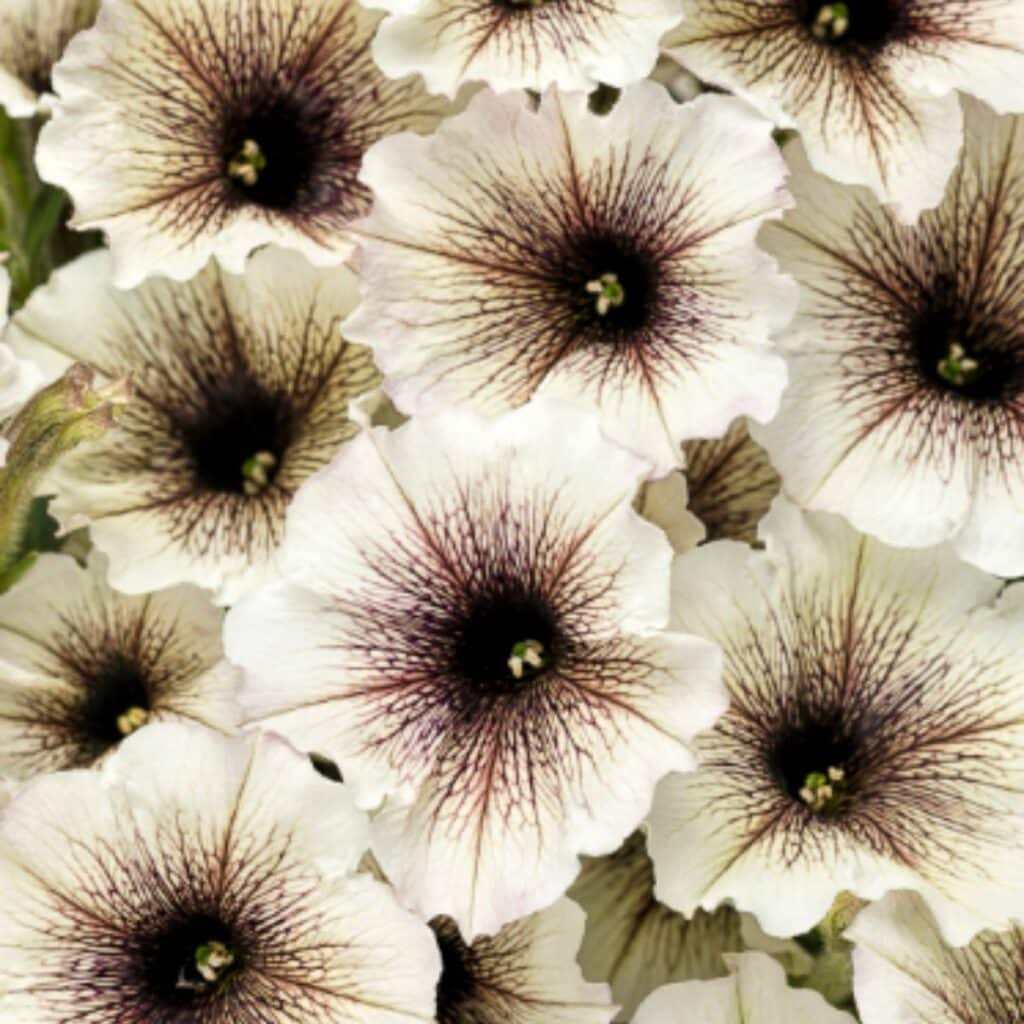
These are technically petunias, but I’ve given them a separate listing because people now ask for them by name. They bloom profusely and don’t have the sticky foliage petunias are known for.
These colorful plants have a trailing growth habit and are great in hanging baskets, planters, pots, and window boxes. They can also be used as edging plants in the garden.
You can find them in single or double-flower forms in white, yellow, pink, rose, red, blue, and purple. They grow fast and bloom from spring through fall.
The Supetunias have become a favorite, and rightfully so. Check out the Picasso and Latte varieties above – wowza!
Sweet Alyssum
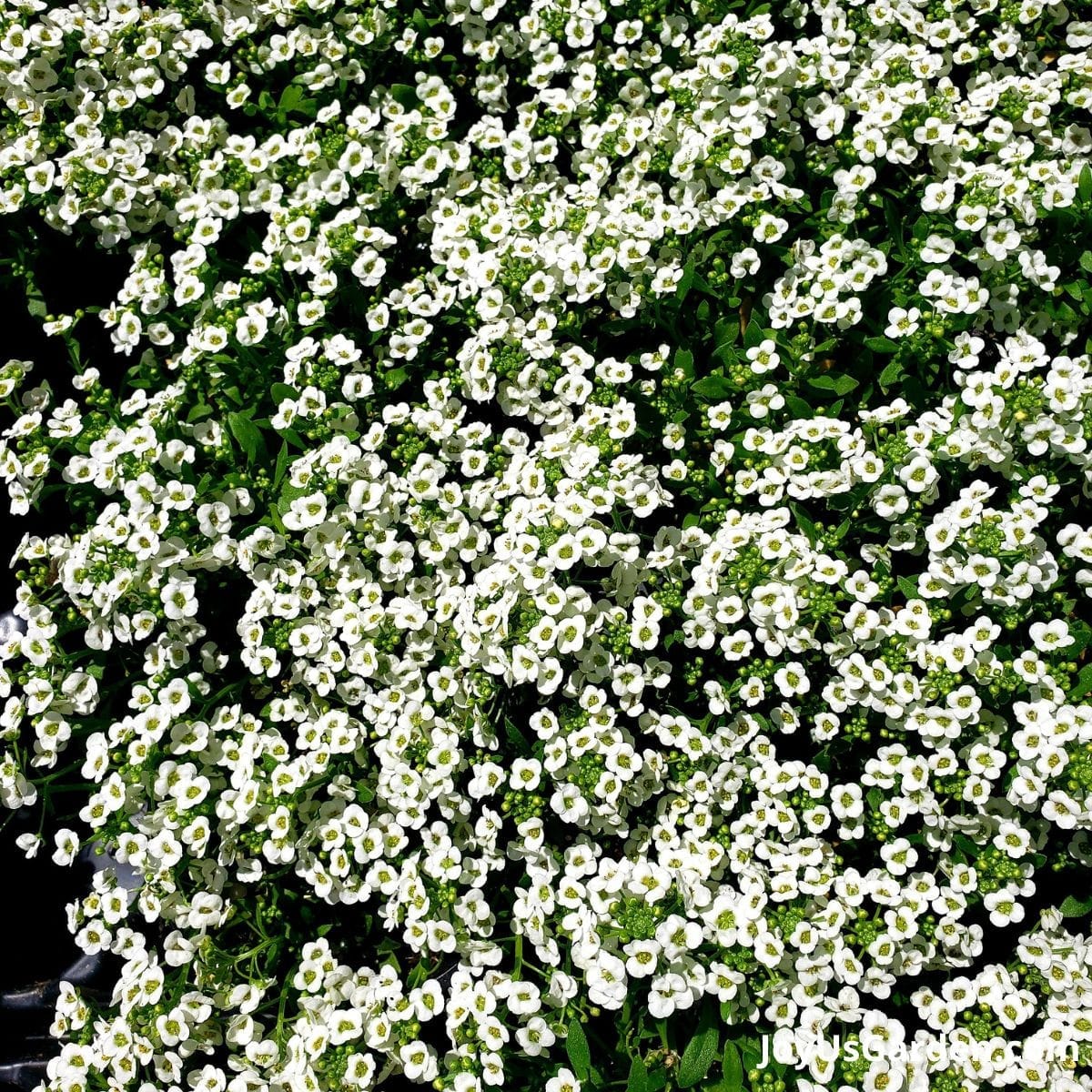
Like lobelia, this can be used as a low-border plant also. It’s an old favorite known for its long-lasting white flowers, which grow in a mounded form.
Besides white, you can find it in shades of lavender and purple and multi-colors. This one has a long bloom time going well into fall in some climates. The approximate size is 8″ x 12″.
It attracts beneficial insects, has a light, pleasant fragrance, and is great in containers of all kinds.
Sweet Peas
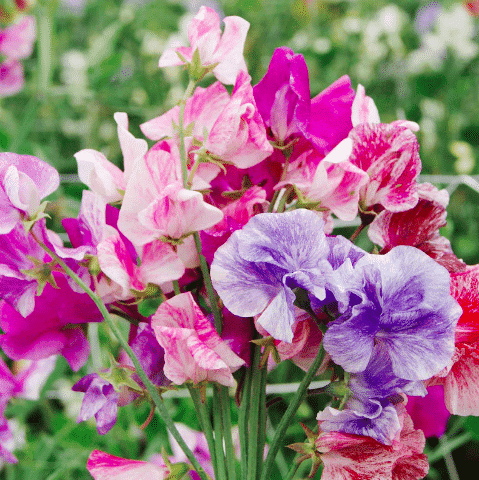
I had a gardening client who loved Sweet Peas. We planted multiple plants for her in late spring, so the nosegays were endless. They’re well suited if you want some height in the garden, as some grow to 9′ tall. The ones we grew for her maxed out at around 6-7′ and grew on rose pillars and trellises’.
Sweet Peas not only give you striking colors but a strong sweet scent. You can find them in white, pink, salmon, lavender, red, maroon, and bi-color combos.
These quintessential cottage garden plants need support when growing. You can use various structures for initial training, such as a trellis or fence and twine or wire. They will give you the most bountiful blooms when planted in nutrient-rich soil and with regular fertilizing.
Knee-high Sweet Peas grow to 2-3′ if you like these flowers but prefer something you don’t have to train.
Verbena
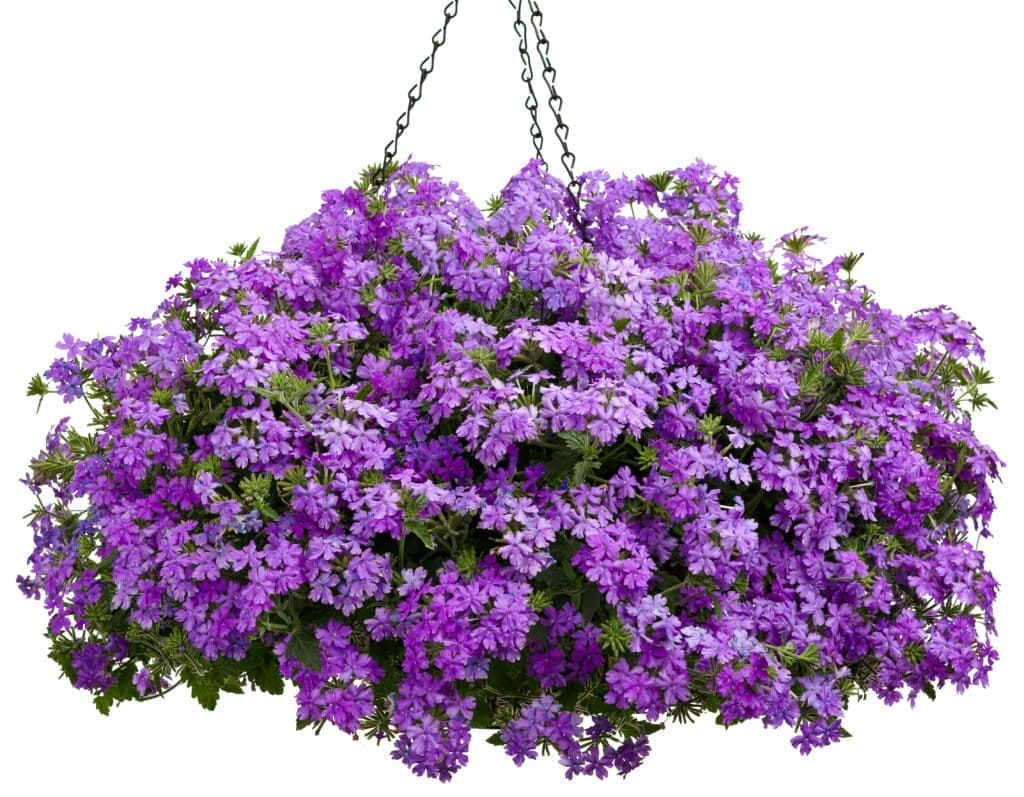
Annual Verbena or Hybrid Verbena tend to have more of a spreading, trailing habit than their perennial counterparts. On average, they grow to 12″ x 24″.
They come in white, pink, red, and purple. This is a great plant to grow in containers and hanging baskets as it’s more delicate and won’t overtake and crowd out other annuals.
Butterflies love these!
Vinca
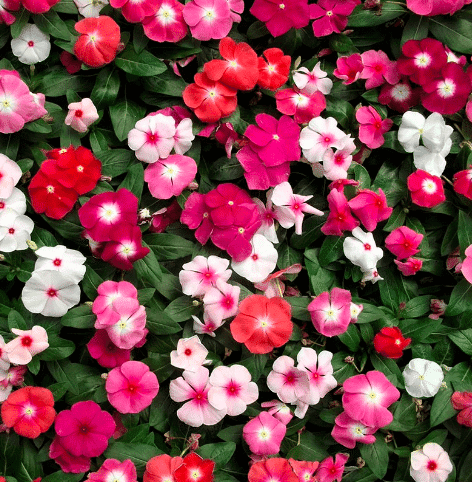
You can’t but fall in love with the Annual Vinca. This plant is well-known for surviving the hottest day of summer and still coming out looking gorgeous.
I live in the Arizona desert, and this is the one that stands to the heat of summer and the intense sun. You can find them in white, pink, red, purple, and magenta, ranging from 10″ to 20″. I have a big pot full of them on my patio, and looking at their cheery, vibrant blooms makes me smile every time I see them!
There’s a cascading variety suited to spill out containers and grow in hanging baskets.
Zinnias
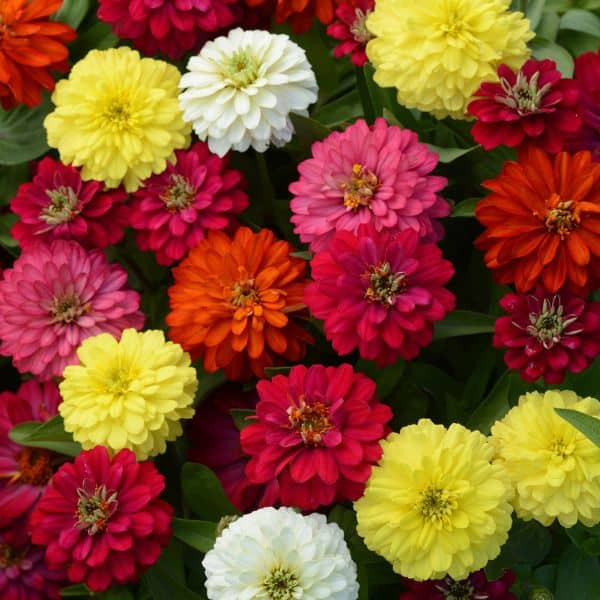
A beautiful daisy-like flower, the ever-popular Zinnia can be found in pink, yellow, red, white, green, and bi-colors. Butterflies and pollinators love this one!
They’re one of the easiest flowers to look after and well-suited for a sunny garden. Described as a hot-climate plant, Zinnias fit the bill when searching for a low-maintenance plant that can thrive in the summer heat.
You can find short varieties (starting at 6″) as well as tall varieties (to 4′). They’re one of my favorite flowers and have been for years.
And they’re very popular in flower beds and make great cut flowers.
Full sun annuals are pretty spectacular and are easier to care for than you’d think. I hope you enjoyed our list of colorful flowers and bedding plants for full sun that would make a good addition to your outdoor space.
Happy gardening,

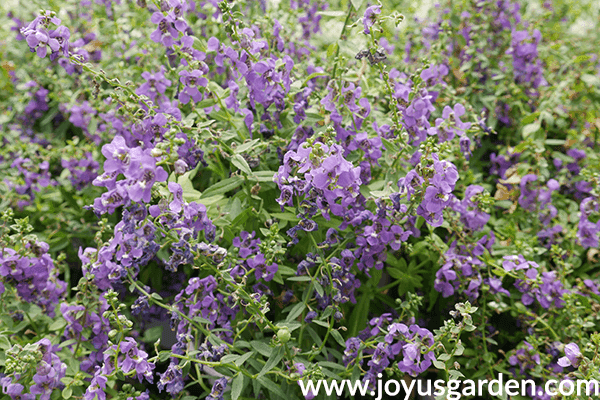
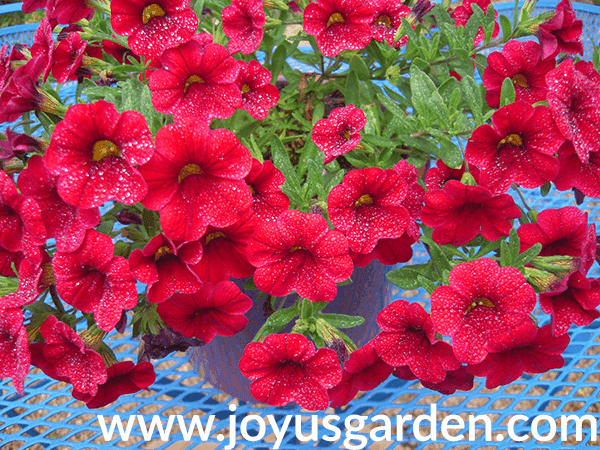
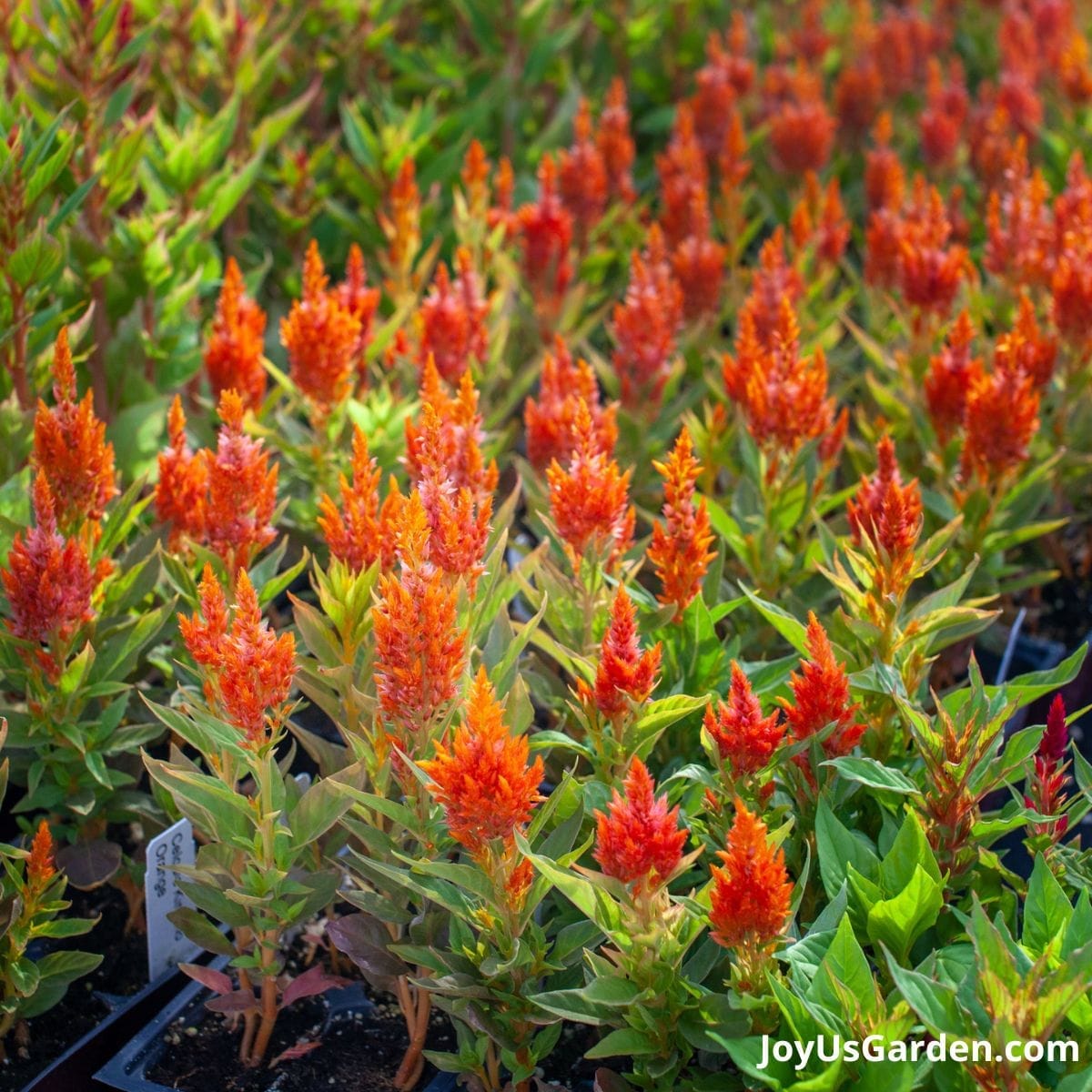
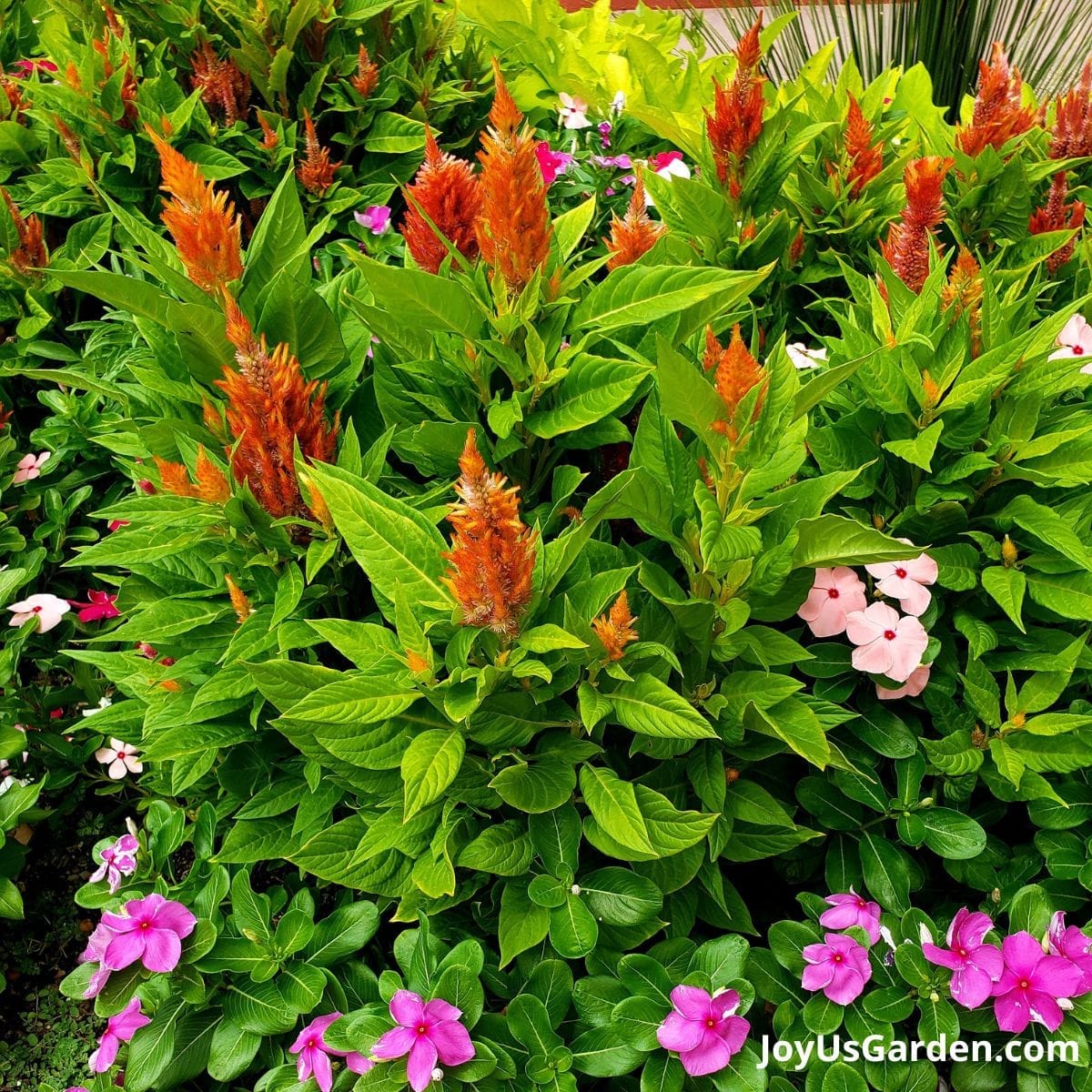
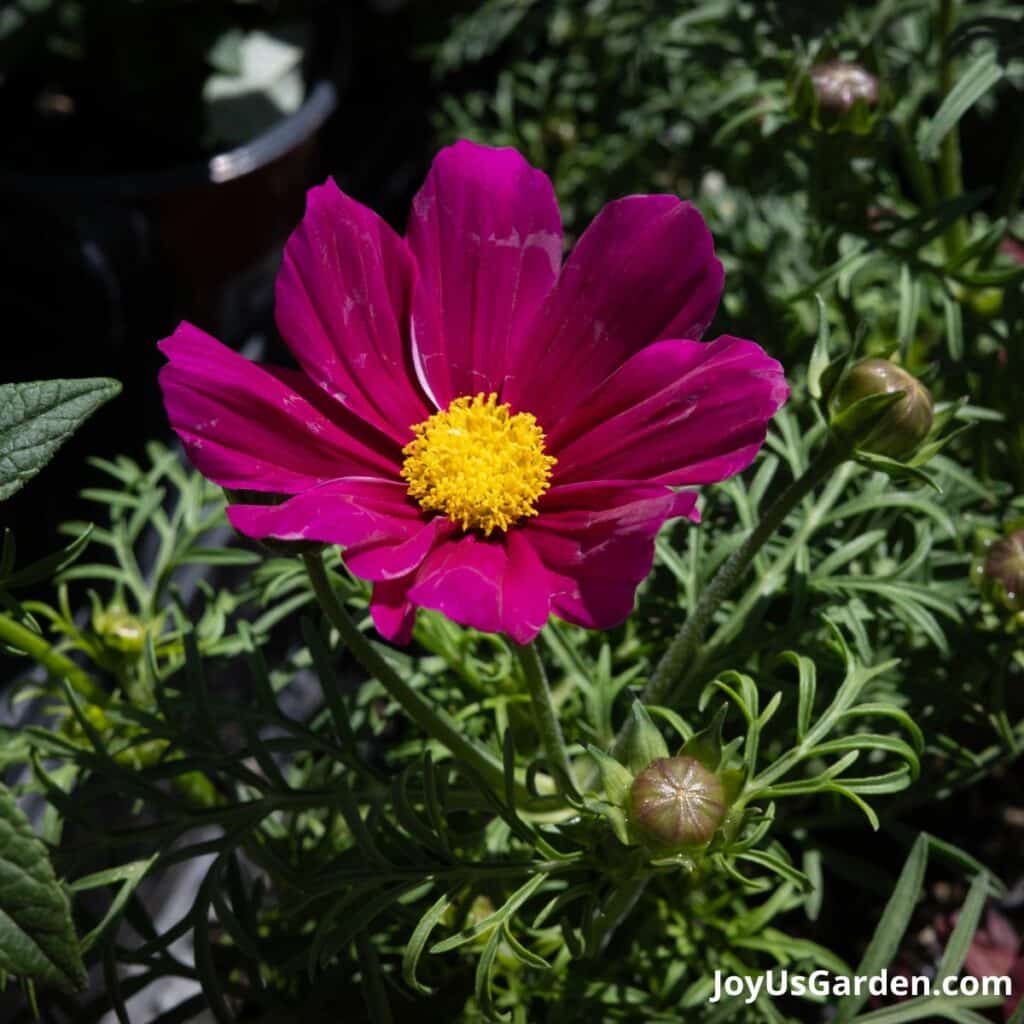
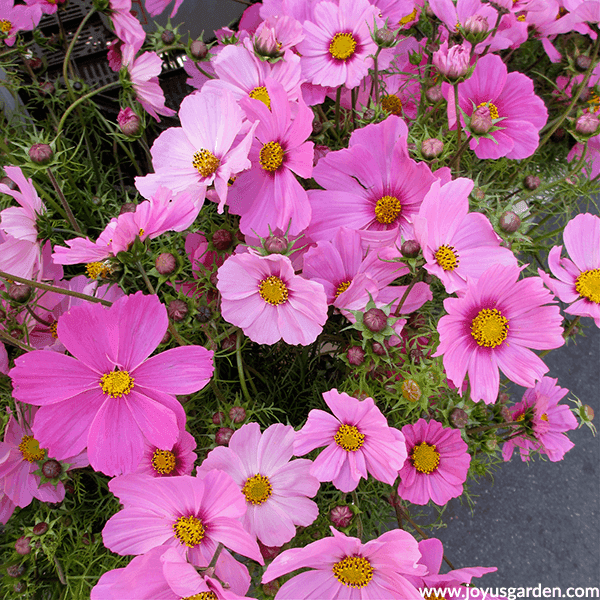
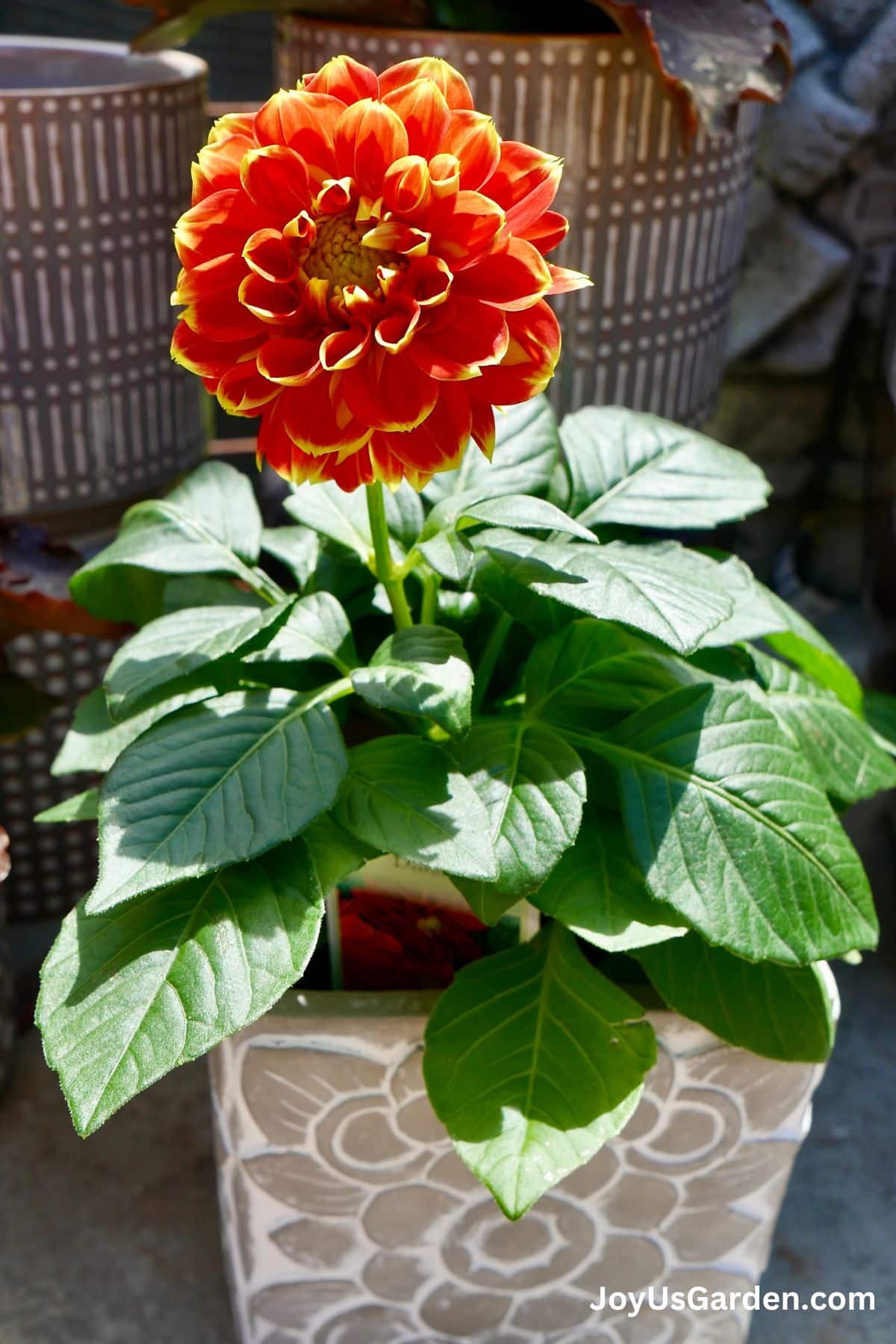

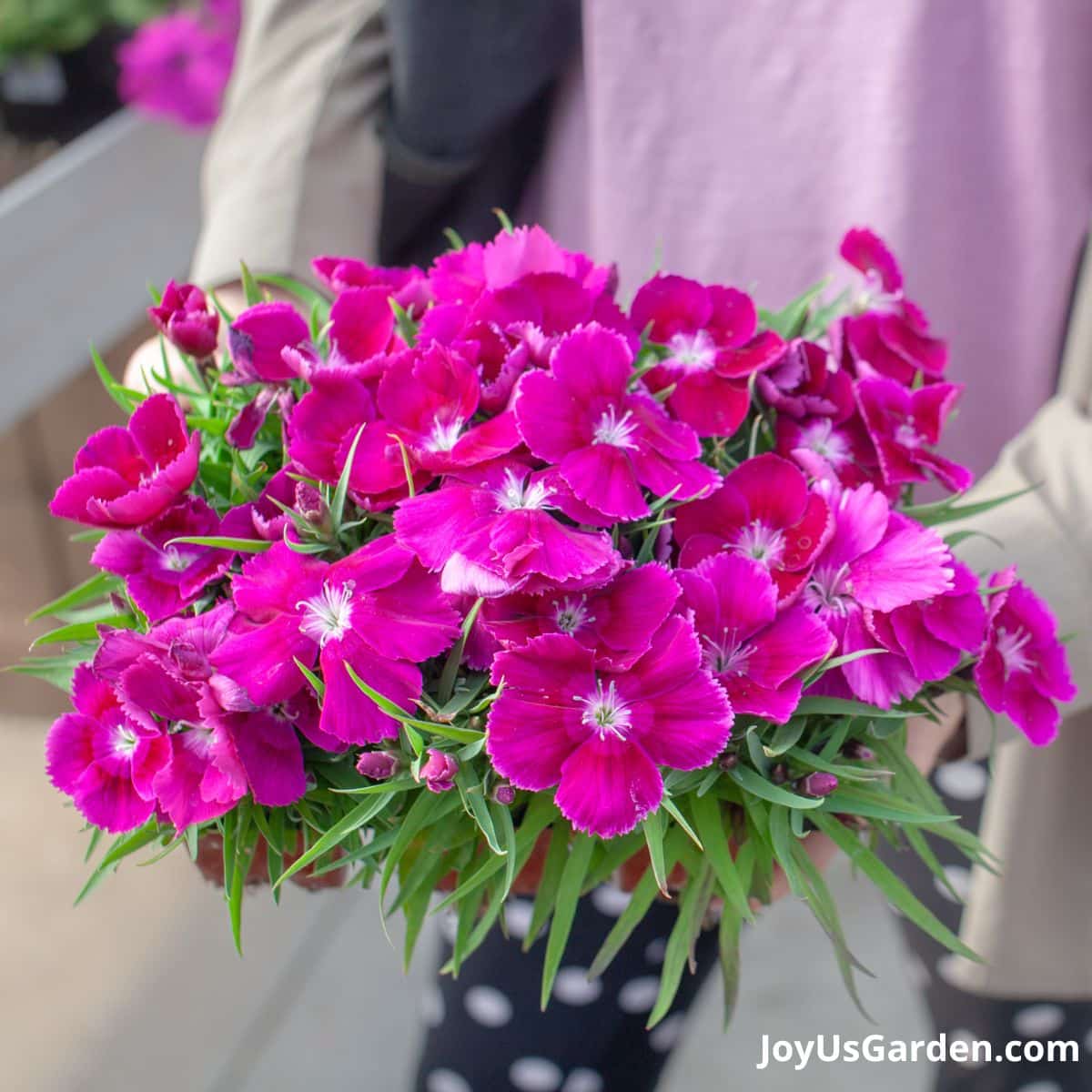
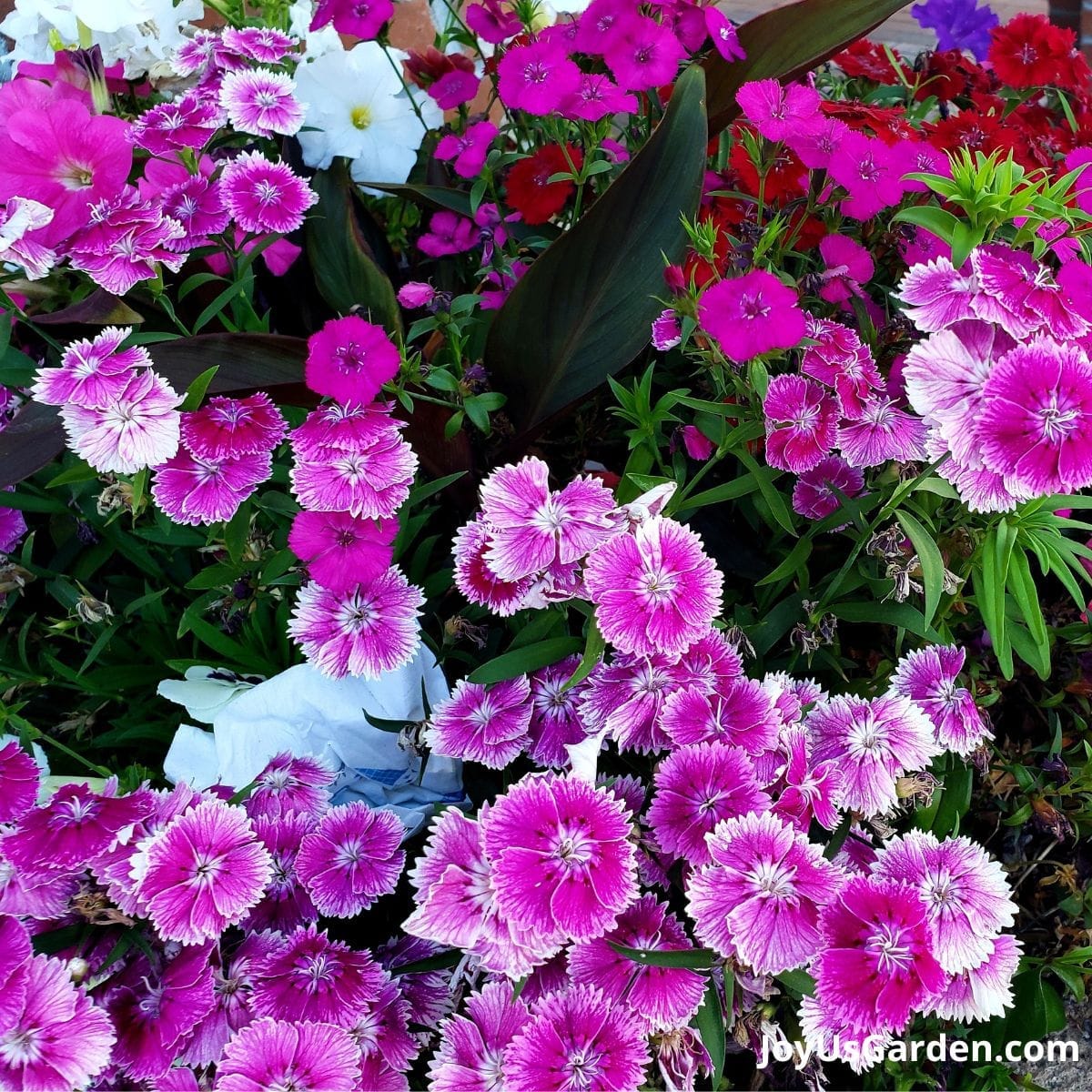
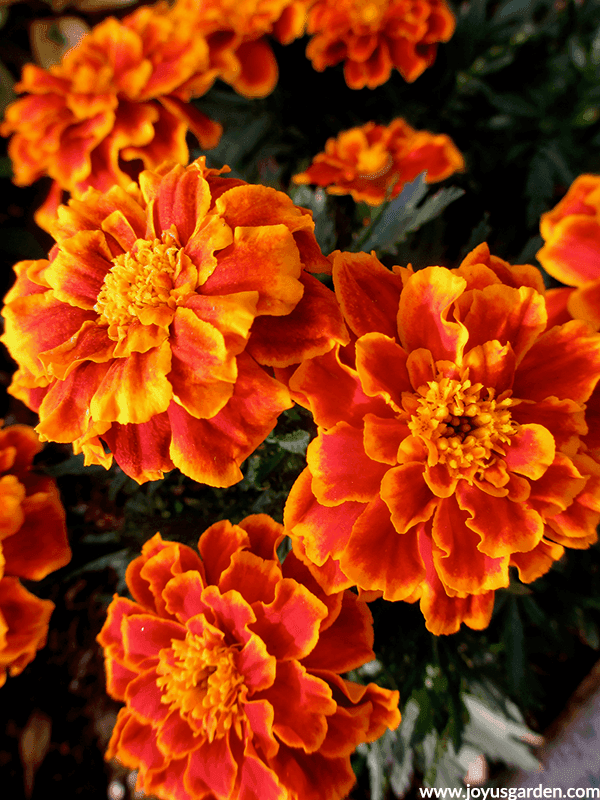
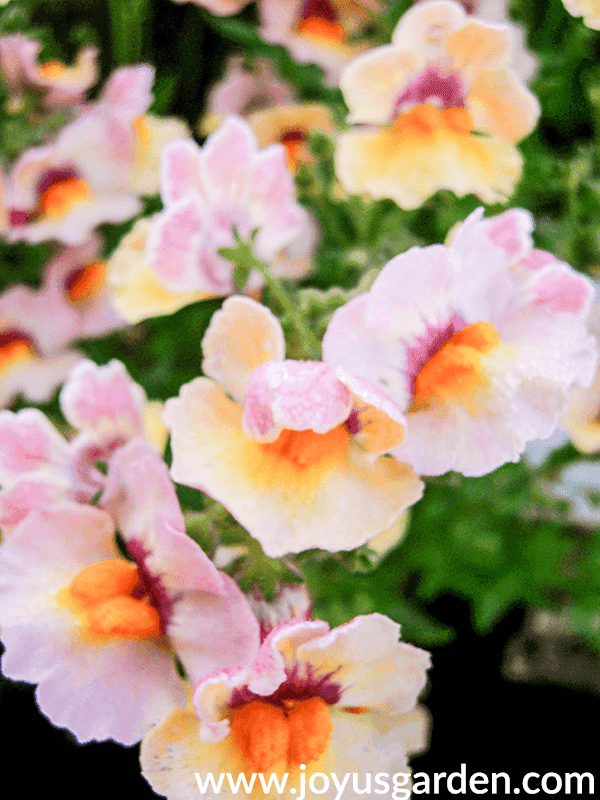
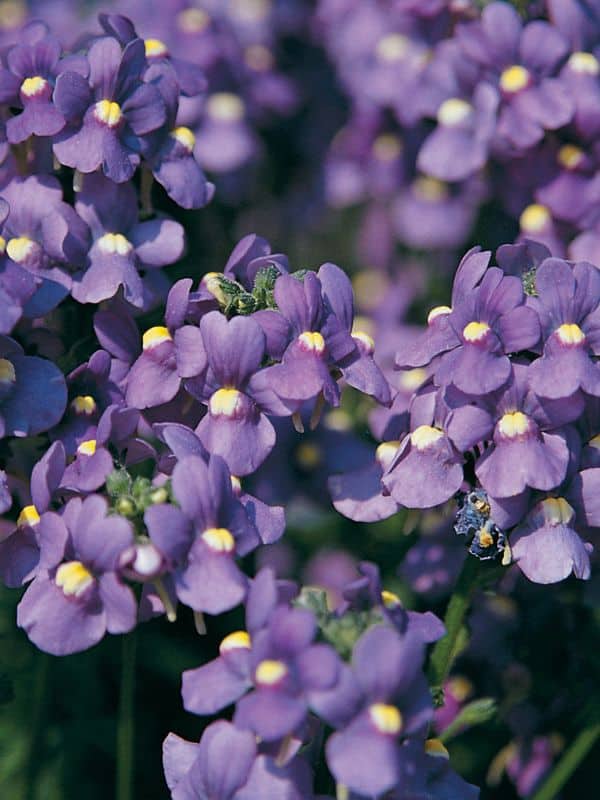
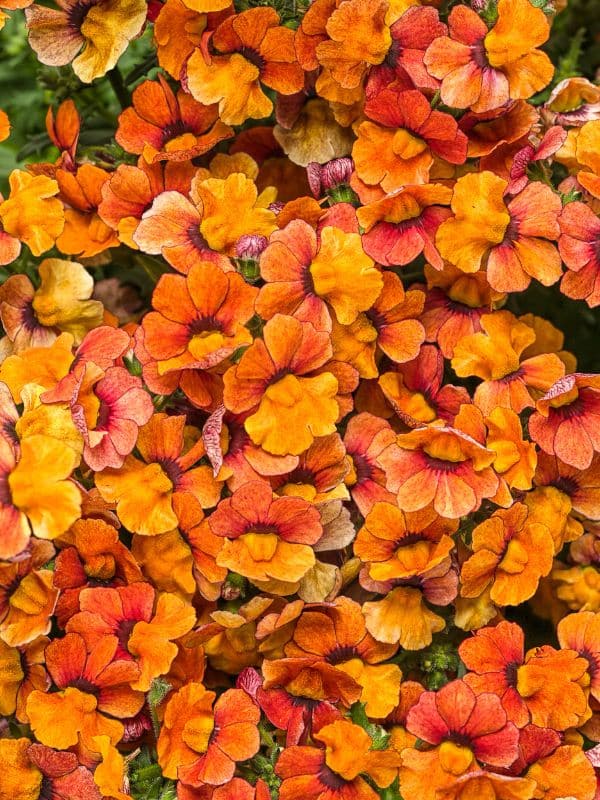
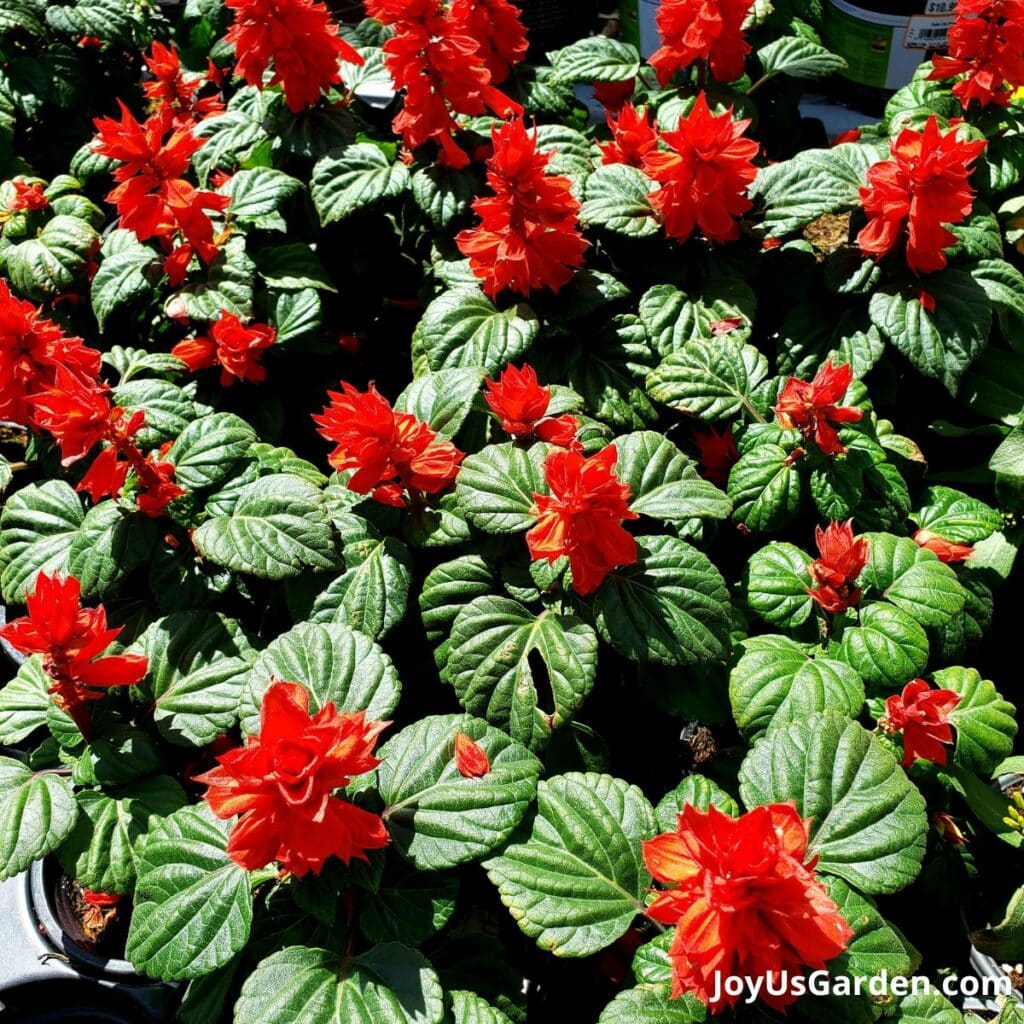
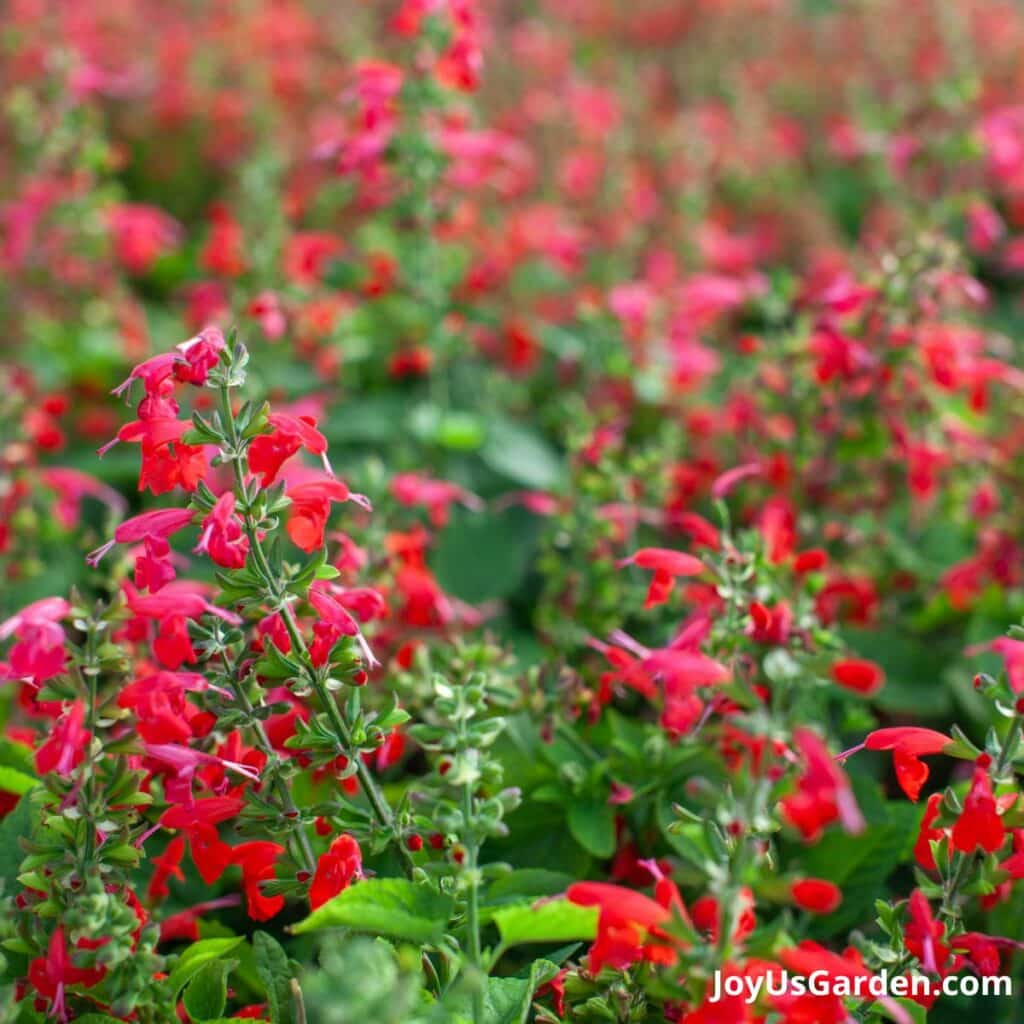
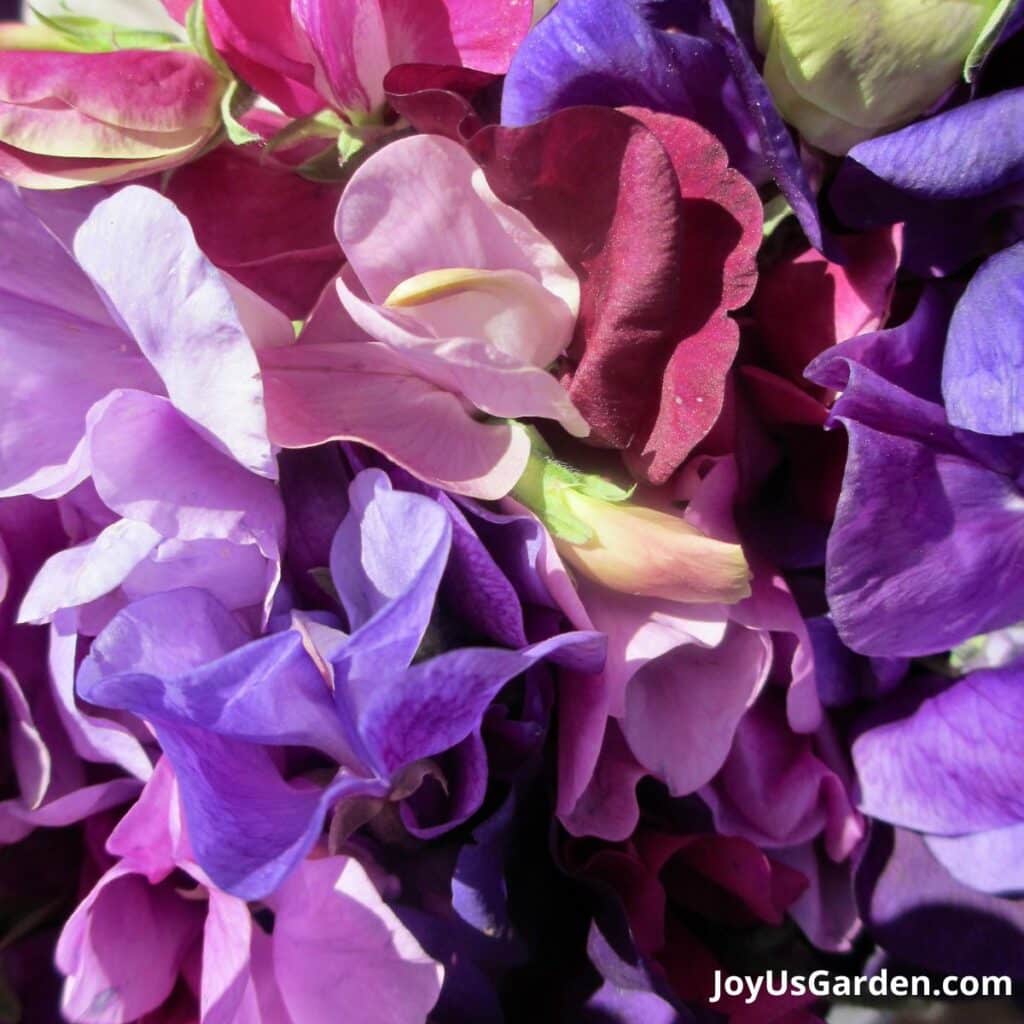

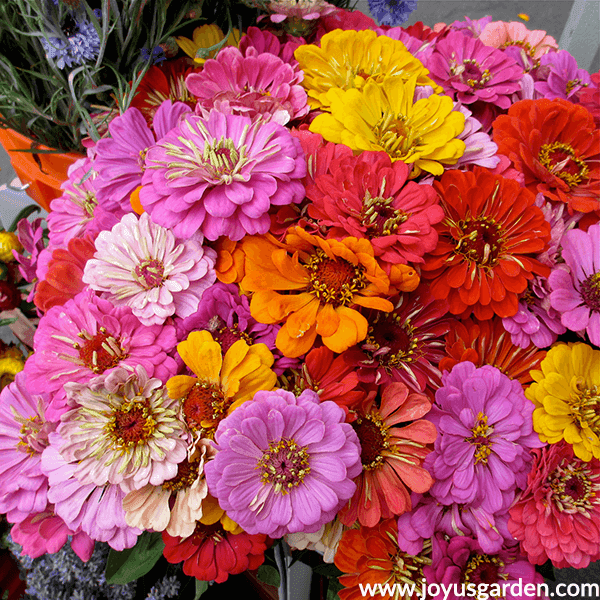

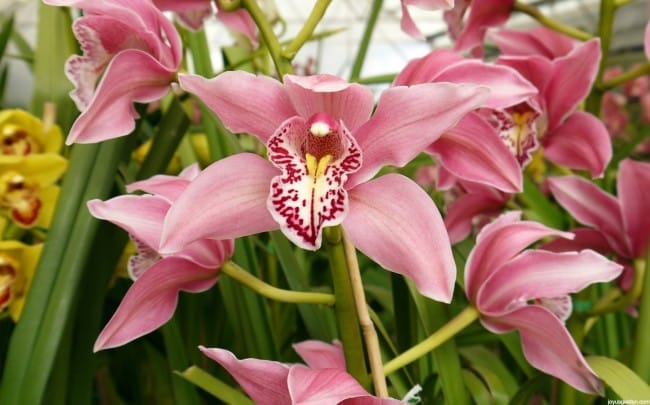
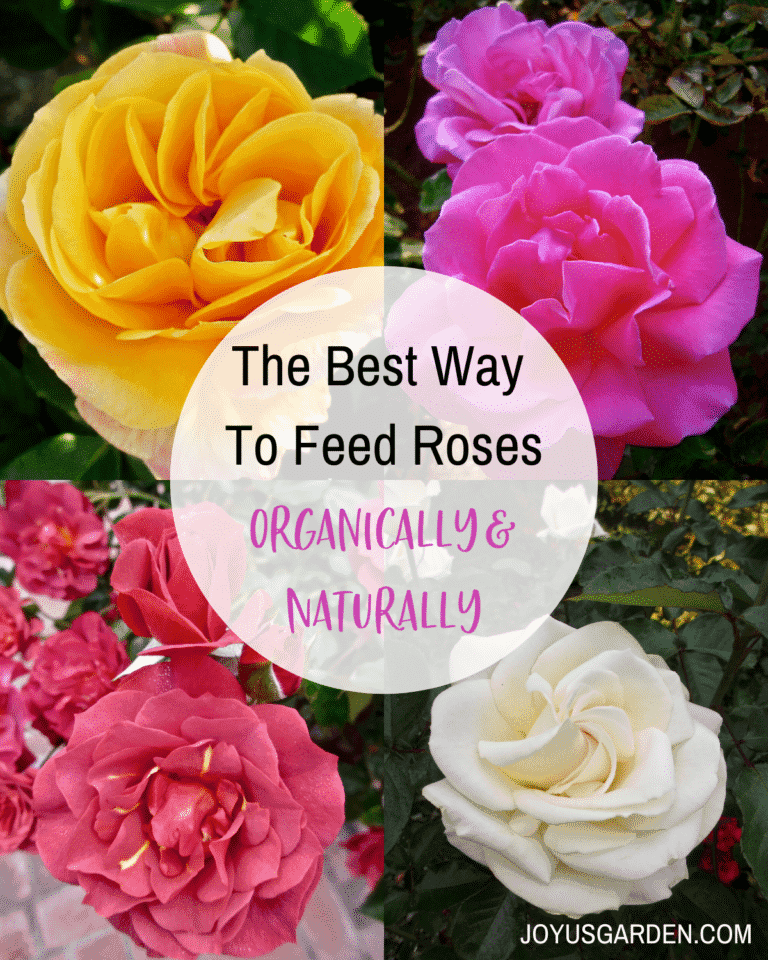
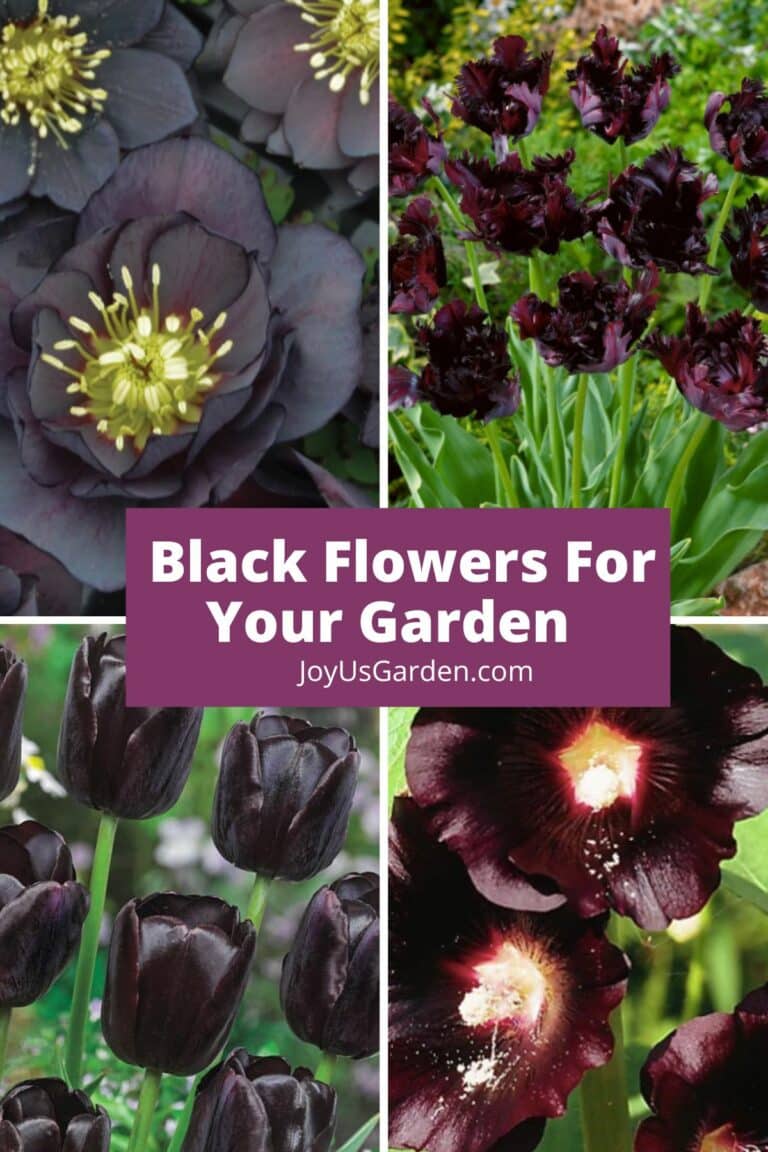
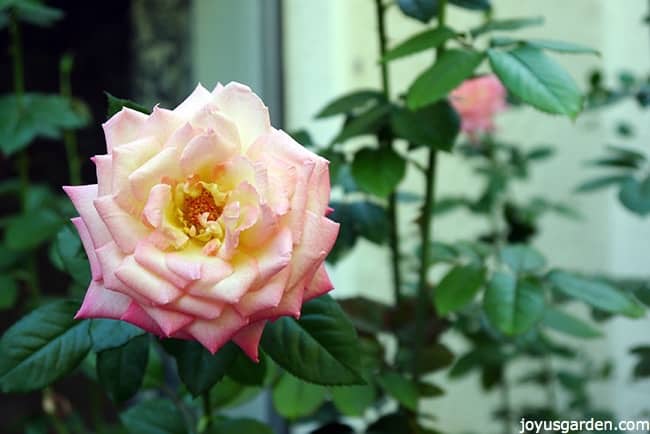

I live in New England and just purchased a 13″ annual hanging basket. I’m told this is the best selection for shade and sunny days. Temps are getting ready to spiral downward “artic.” Should I bring the hanging baskets inside. The flowers are soooo beautiful on my balcony, and I don’t want to destroy before the summer begins.
What do you recommend. Thank You
Remain safe, healthy and blessed!
Hi Darea – I grew up in New England. Most annuals can take it to 40-45F no problem but ARCTIC will be a problem. Take it in. Nell